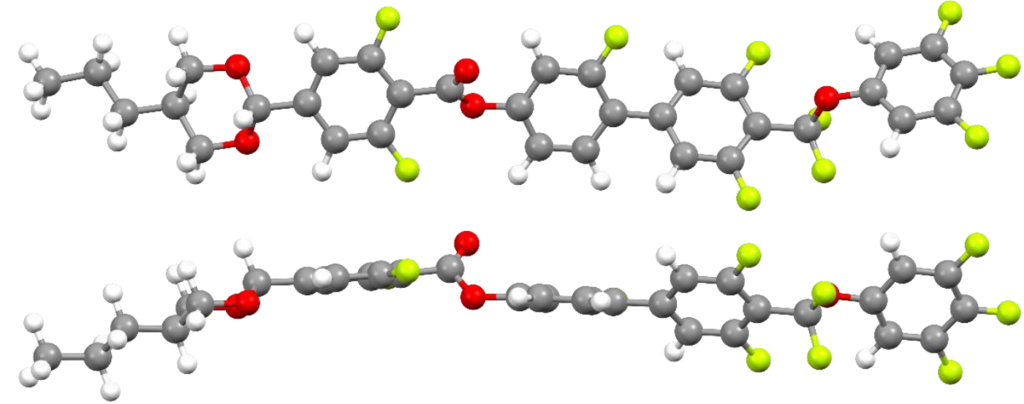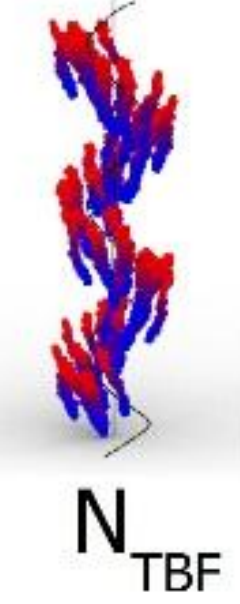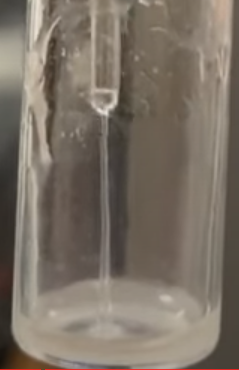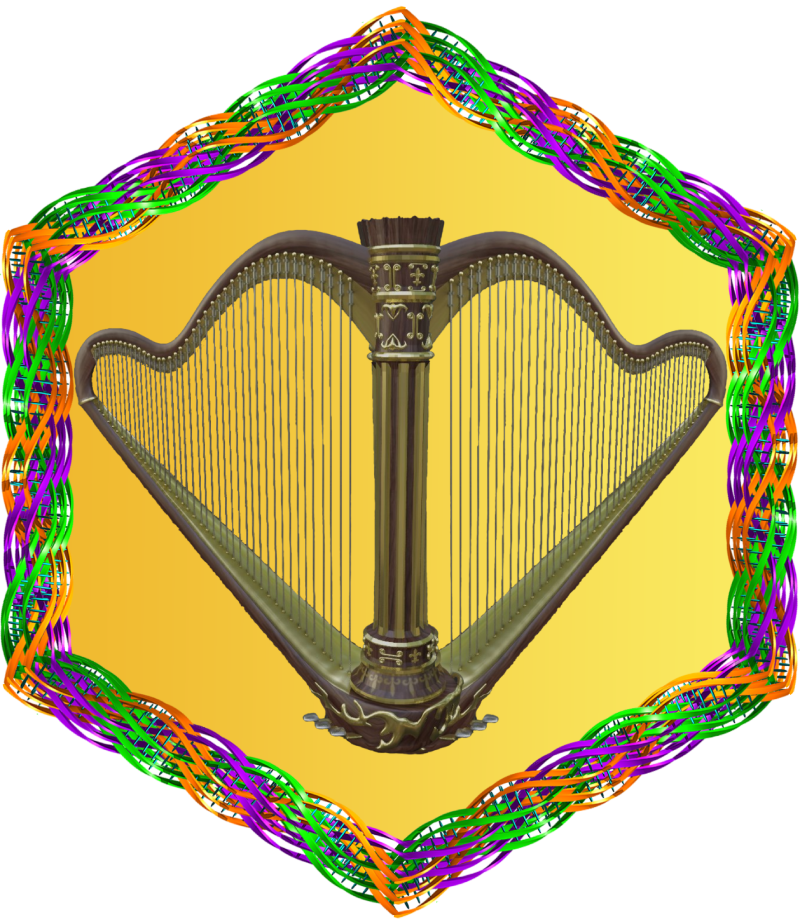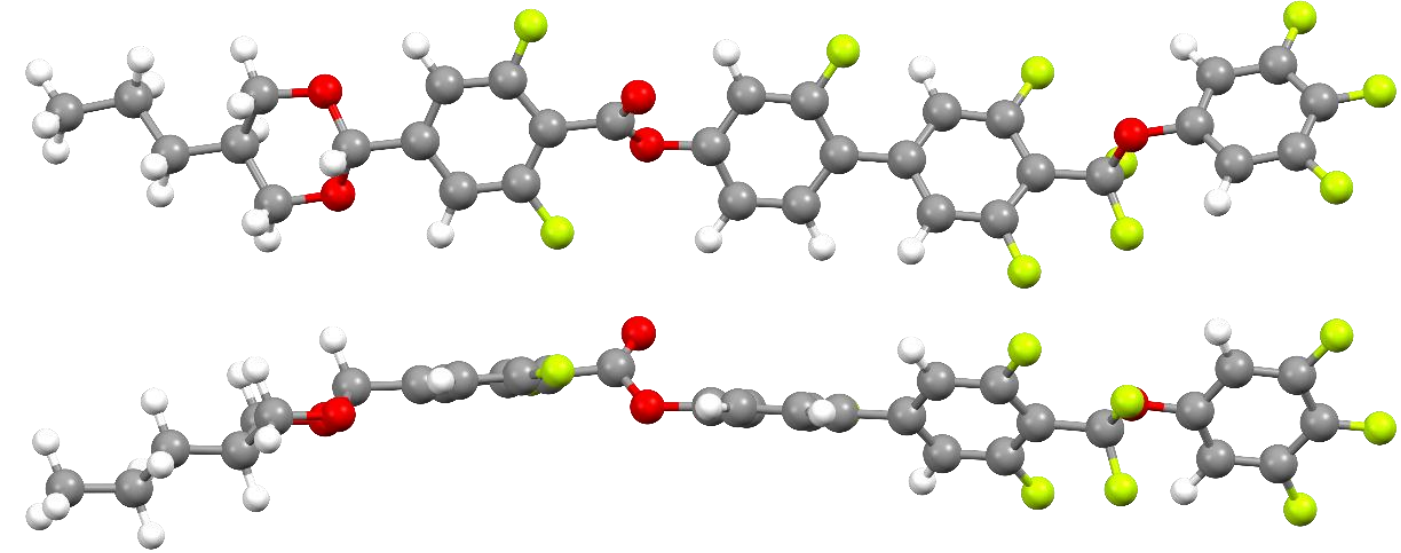Molecular structure of ferroelectric helical phase, formed spontaneously from achiral molecules The exploration of liquid crystals has taken a significant turn with recent findings published in the June 2024 issue of Science
Dual Symmetry Breaking discovery Heliconical Traditionally, chiral structures in liquid crystals have been induced either by the molecular shape or by the addition of chiral substances. However, the new ferroelectric nematic phase described by Karcz et al. breaks away from this convention. It demonstrates how electric dipole interactions, analogous to magnetic interactions in spin systems, can lead to a complex chiral order. This phenomenon is akin to the Dzyaloshinskii-Moriya interaction observed in magnetic materials, which compels magnetic moments to align in non-trivial, often chiral patterns.
In these novel materials, the molecules arrange themselves in a heliconical pattern where the pitch—the distance over which the helical structure repeats—is comparable to the wavelength of visible light. This arrangement not only allows for the selective reflection of light, a property tunable by changes in temperature or the application of an electric field but also introduces a new mechanism for controlling light in advanced optical applications.
Experimental Methodology: Unraveling Polar and Chiral Properties The experimental approach taken by Jakub Karcz and his team was meticulously designed to probe the emergence of polar and chiral properties in ferroelectric nematic phases. This section delves into the specific techniques and tools used to discover and characterize these groundbreaking properties.
Synthesis Synthesis of Nematic Phases: The study began with the synthesis of a novel ferroelectric nematic liquid crystal compound, which does not inherently possess chiral properties. This compound was designed to have a strong electric dipole moment aligned along the molecular axis, essential for the development of ferroelectric properties in the nematic phase. The chemical synthesis involved multiple steps, ensuring the precise arrangement and orientation of functional groups to enhance the polar interactions responsible for the emergent chirality.
Characterization Techniques:
Differential Scanning Calorimetry (DSC): Used to determine the thermal properties of the synthesized compounds, identifying the temperature ranges over which the material transitions between different phases.Polarized Optical Microscopy (POM): Key for visually assessing the molecular alignment and the texture of the phases, allowing direct observation of the heliconical structure formation.X-ray Diffraction: Pivotal in confirming the non-collinear arrangement of electric dipoles, providing insights into the molecular spacing and orientation.Electro-optical Measurements: Conducted to study the material’s response to electric fields, crucial for demonstrating the ability to control the helical pitch and reflection properties.Implications for Technology and Theory The implications of these findings are profound, opening up potential applications in fields ranging from advanced display technologies to sensors and beyond. For instance, materials that can change their optical properties in response to environmental stimuli are crucial for the development of responsive, energy-efficient smart materials and devices.
Conclusion The discovery of polar and chiral symmetry breaking in spontaneous ferroelectric nematic phases marks a notable advancement in the field of materials science. As we continue to explore the full implications of these findings, the integration of such materials into practical applications looms on the horizon, promising a new era of material functionality that harnesses the intricate interplay of polarity and chirality for technological innovation.
References
{14686113:UYT4ETXP};{14686113:3MW3FSCW},{14686113:VMH2DS7T}
vancouver
default
0
746 %7B%22status%22%3A%22success%22%2C%22updateneeded%22%3Afalse%2C%22instance%22%3Afalse%2C%22meta%22%3A%7B%22request_last%22%3A0%2C%22request_next%22%3A0%2C%22used_cache%22%3Atrue%7D%2C%22data%22%3A%5B%7B%22key%22%3A%22HMA5MR7A%22%2C%22library%22%3A%7B%22id%22%3A14686113%7D%2C%22meta%22%3A%7B%22creatorSummary%22%3A%22Nalitov%20et%20al.%22%2C%22parsedDate%22%3A%222019-03-15%22%2C%22numChildren%22%3A1%7D%2C%22bib%22%3A%22%26lt%3Bdiv%20class%3D%26quot%3Bcsl-bib-body%26quot%3B%20style%3D%26quot%3Bline-height%3A%201.35%3B%20%26quot%3B%26gt%3B%5Cn%20%20%26lt%3Bdiv%20class%3D%26quot%3Bcsl-entry%26quot%3B%20style%3D%26quot%3Bclear%3A%20left%3B%20%26quot%3B%26gt%3B%5Cn%20%20%20%20%26lt%3Bdiv%20class%3D%26quot%3Bcsl-left-margin%26quot%3B%20style%3D%26quot%3Bfloat%3A%20left%3B%20padding-right%3A%200.5em%3B%20text-align%3A%20right%3B%20width%3A%201em%3B%26quot%3B%26gt%3B1.%26lt%3B%5C%2Fdiv%26gt%3B%26lt%3Bdiv%20class%3D%26quot%3Bcsl-right-inline%26quot%3B%20style%3D%26quot%3Bmargin%3A%200%20.4em%200%201.5em%3B%26quot%3B%26gt%3BNalitov%20AV%2C%20Sigurdsson%20H%2C%20Morina%20S%2C%20Krivosenko%20YS%2C%20Iorsh%20IV%2C%20Rubo%20YG%2C%20et%20al.%20Optically%20trapped%20polariton%20condensates%20as%20semiclassical%20time%20crystals.%20Phys%20Rev%20A%20%5BInternet%5D.%202019%20Mar%2015%20%5Bcited%202024%20Oct%2013%5D%3B99%283%29%3A033830.%20Available%20from%3A%20%26lt%3Ba%20class%3D%26%23039%3Bzp-ItemURL%26%23039%3B%20href%3D%26%23039%3Bhttps%3A%5C%2F%5C%2Flink.aps.org%5C%2Fdoi%5C%2F10.1103%5C%2FPhysRevA.99.033830%26%23039%3B%26gt%3Bhttps%3A%5C%2F%5C%2Flink.aps.org%5C%2Fdoi%5C%2F10.1103%5C%2FPhysRevA.99.033830%26lt%3B%5C%2Fa%26gt%3B%26lt%3B%5C%2Fdiv%26gt%3B%5Cn%20%20%26lt%3B%5C%2Fdiv%26gt%3B%5Cn%26lt%3B%5C%2Fdiv%26gt%3B%22%2C%22data%22%3A%7B%22itemType%22%3A%22journalArticle%22%2C%22title%22%3A%22Optically%20trapped%20polariton%20condensates%20as%20semiclassical%20time%20crystals%22%2C%22creators%22%3A%5B%7B%22creatorType%22%3A%22author%22%2C%22firstName%22%3A%22A.%20V.%22%2C%22lastName%22%3A%22Nalitov%22%7D%2C%7B%22creatorType%22%3A%22author%22%2C%22firstName%22%3A%22H.%22%2C%22lastName%22%3A%22Sigurdsson%22%7D%2C%7B%22creatorType%22%3A%22author%22%2C%22firstName%22%3A%22S.%22%2C%22lastName%22%3A%22Morina%22%7D%2C%7B%22creatorType%22%3A%22author%22%2C%22firstName%22%3A%22Y.%20S.%22%2C%22lastName%22%3A%22Krivosenko%22%7D%2C%7B%22creatorType%22%3A%22author%22%2C%22firstName%22%3A%22I.%20V.%22%2C%22lastName%22%3A%22Iorsh%22%7D%2C%7B%22creatorType%22%3A%22author%22%2C%22firstName%22%3A%22Y.%20G.%22%2C%22lastName%22%3A%22Rubo%22%7D%2C%7B%22creatorType%22%3A%22author%22%2C%22firstName%22%3A%22A.%20V.%22%2C%22lastName%22%3A%22Kavokin%22%7D%2C%7B%22creatorType%22%3A%22author%22%2C%22firstName%22%3A%22I.%20A.%22%2C%22lastName%22%3A%22Shelykh%22%7D%5D%2C%22abstractNote%22%3A%22%22%2C%22date%22%3A%222019-3-15%22%2C%22language%22%3A%22en%22%2C%22DOI%22%3A%2210.1103%5C%2FPhysRevA.99.033830%22%2C%22ISSN%22%3A%222469-9926%2C%202469-9934%22%2C%22url%22%3A%22https%3A%5C%2F%5C%2Flink.aps.org%5C%2Fdoi%5C%2F10.1103%5C%2FPhysRevA.99.033830%22%2C%22collections%22%3A%5B%22HI8C23R8%22%5D%2C%22dateModified%22%3A%222024-10-13T15%3A43%3A56Z%22%7D%7D%2C%7B%22key%22%3A%228L5SUKLH%22%2C%22library%22%3A%7B%22id%22%3A14686113%7D%2C%22meta%22%3A%7B%22numChildren%22%3A0%7D%2C%22bib%22%3A%22%26lt%3Bdiv%20class%3D%26quot%3Bcsl-bib-body%26quot%3B%20style%3D%26quot%3Bline-height%3A%201.35%3B%20%26quot%3B%26gt%3B%5Cn%20%20%26lt%3Bdiv%20class%3D%26quot%3Bcsl-entry%26quot%3B%20style%3D%26quot%3Bclear%3A%20left%3B%20%26quot%3B%26gt%3B%5Cn%20%20%20%20%26lt%3Bdiv%20class%3D%26quot%3Bcsl-left-margin%26quot%3B%20style%3D%26quot%3Bfloat%3A%20left%3B%20padding-right%3A%200.5em%3B%20text-align%3A%20right%3B%20width%3A%201em%3B%26quot%3B%26gt%3B1.%26lt%3B%5C%2Fdiv%26gt%3B%26lt%3B%5C%2Fdiv%26gt%3B%5Cn%26lt%3B%5C%2Fdiv%26gt%3B%22%2C%22data%22%3A%7B%22itemType%22%3A%22journalArticle%22%2C%22title%22%3A%22%22%2C%22creators%22%3A%5B%5D%2C%22abstractNote%22%3A%22%22%2C%22date%22%3A%22%22%2C%22language%22%3A%22%22%2C%22DOI%22%3A%22%22%2C%22ISSN%22%3A%22%22%2C%22url%22%3A%22%22%2C%22collections%22%3A%5B%5D%2C%22dateModified%22%3A%222024-10-13T15%3A43%3A29Z%22%7D%7D%2C%7B%22key%22%3A%22JUEFERMF%22%2C%22library%22%3A%7B%22id%22%3A14686113%7D%2C%22meta%22%3A%7B%22numChildren%22%3A0%7D%2C%22bib%22%3A%22%26lt%3Bdiv%20class%3D%26quot%3Bcsl-bib-body%26quot%3B%20style%3D%26quot%3Bline-height%3A%201.35%3B%20%26quot%3B%26gt%3B%5Cn%20%20%26lt%3Bdiv%20class%3D%26quot%3Bcsl-entry%26quot%3B%20style%3D%26quot%3Bclear%3A%20left%3B%20%26quot%3B%26gt%3B%5Cn%20%20%20%20%26lt%3Bdiv%20class%3D%26quot%3Bcsl-left-margin%26quot%3B%20style%3D%26quot%3Bfloat%3A%20left%3B%20padding-right%3A%200.5em%3B%20text-align%3A%20right%3B%20width%3A%201em%3B%26quot%3B%26gt%3B1.%26lt%3B%5C%2Fdiv%26gt%3B%26lt%3B%5C%2Fdiv%26gt%3B%5Cn%26lt%3B%5C%2Fdiv%26gt%3B%22%2C%22data%22%3A%7B%22itemType%22%3A%22journalArticle%22%2C%22title%22%3A%22%22%2C%22creators%22%3A%5B%5D%2C%22abstractNote%22%3A%22%22%2C%22date%22%3A%22%22%2C%22language%22%3A%22%22%2C%22DOI%22%3A%22%22%2C%22ISSN%22%3A%22%22%2C%22url%22%3A%22%22%2C%22collections%22%3A%5B%5D%2C%22dateModified%22%3A%222024-10-13T15%3A43%3A12Z%22%7D%7D%2C%7B%22key%22%3A%22P64S3VIK%22%2C%22library%22%3A%7B%22id%22%3A14686113%7D%2C%22meta%22%3A%7B%22creatorSummary%22%3A%22Lustig%20et%20al.%22%2C%22parsedDate%22%3A%222023-03-13%22%2C%22numChildren%22%3A1%7D%2C%22bib%22%3A%22%26lt%3Bdiv%20class%3D%26quot%3Bcsl-bib-body%26quot%3B%20style%3D%26quot%3Bline-height%3A%201.35%3B%20%26quot%3B%26gt%3B%5Cn%20%20%26lt%3Bdiv%20class%3D%26quot%3Bcsl-entry%26quot%3B%20style%3D%26quot%3Bclear%3A%20left%3B%20%26quot%3B%26gt%3B%5Cn%20%20%20%20%26lt%3Bdiv%20class%3D%26quot%3Bcsl-left-margin%26quot%3B%20style%3D%26quot%3Bfloat%3A%20left%3B%20padding-right%3A%200.5em%3B%20text-align%3A%20right%3B%20width%3A%201em%3B%26quot%3B%26gt%3B1.%26lt%3B%5C%2Fdiv%26gt%3B%26lt%3Bdiv%20class%3D%26quot%3Bcsl-right-inline%26quot%3B%20style%3D%26quot%3Bmargin%3A%200%20.4em%200%201.5em%3B%26quot%3B%26gt%3BLustig%20E%2C%20Segal%20O%2C%20Saha%20S%2C%20Fruhling%20C%2C%20Shalaev%20VM%2C%20Boltasseva%20A%2C%20et%20al.%20Photonic%20time-crystals%20-%20fundamental%20concepts%20%5BInvited%5D.%20Optics%20Express%2C%20Vol%2031%2C%20Issue%206%2C%20pp%209165-9170%20%5BInternet%5D.%202023%20Mar%2013%20%5Bcited%202024%20Sep%209%5D%3B%20Available%20from%3A%20%26lt%3Ba%20class%3D%26%23039%3Bzp-ItemURL%26%23039%3B%20href%3D%26%23039%3Bhttps%3A%5C%2F%5C%2Fopg.optica.org%5C%2Foe%5C%2Fabstract.cfm%3Furi%3Doe-31-6-9165%26%23039%3B%26gt%3Bhttps%3A%5C%2F%5C%2Fopg.optica.org%5C%2Foe%5C%2Fabstract.cfm%3Furi%3Doe-31-6-9165%26lt%3B%5C%2Fa%26gt%3B%26lt%3B%5C%2Fdiv%26gt%3B%5Cn%20%20%26lt%3B%5C%2Fdiv%26gt%3B%5Cn%26lt%3B%5C%2Fdiv%26gt%3B%22%2C%22data%22%3A%7B%22itemType%22%3A%22journalArticle%22%2C%22title%22%3A%22Photonic%20time-crystals%20-%20fundamental%20concepts%20%5BInvited%5D%22%2C%22creators%22%3A%5B%7B%22creatorType%22%3A%22author%22%2C%22firstName%22%3A%22Eran%22%2C%22lastName%22%3A%22Lustig%22%7D%2C%7B%22creatorType%22%3A%22author%22%2C%22firstName%22%3A%22Ohad%22%2C%22lastName%22%3A%22Segal%22%7D%2C%7B%22creatorType%22%3A%22author%22%2C%22firstName%22%3A%22Soham%22%2C%22lastName%22%3A%22Saha%22%7D%2C%7B%22creatorType%22%3A%22author%22%2C%22firstName%22%3A%22Colton%22%2C%22lastName%22%3A%22Fruhling%22%7D%2C%7B%22creatorType%22%3A%22author%22%2C%22firstName%22%3A%22Vladimir%20M.%22%2C%22lastName%22%3A%22Shalaev%22%7D%2C%7B%22creatorType%22%3A%22author%22%2C%22firstName%22%3A%22Alexandra%22%2C%22lastName%22%3A%22Boltasseva%22%7D%2C%7B%22creatorType%22%3A%22author%22%2C%22firstName%22%3A%22Mordechai%22%2C%22lastName%22%3A%22Segev%22%7D%5D%2C%22abstractNote%22%3A%22Photonic%20Time-Crystals%20%28PTCs%29%20are%20materials%20in%20which%20the%20refractive%20index%20varies%20periodically%20and%20abruptly%20in%20time.%20This%20medium%20exhibits%20unusual%20properties%20such%20as%20momentum%20bands%20separated%20by%20gaps%20within%20which%20waves%20can%20be%20amplified%20exponentially%2C%20extracting%20energy%20from%20the%20modulation.%20This%20article%20provides%20a%20brief%20review%20on%20the%20concepts%20underlying%20PTCs%2C%20formulates%20the%20vision%20and%20discusses%20the%20challenges.%22%2C%22date%22%3A%222023-03-13%22%2C%22language%22%3A%22EN%22%2C%22DOI%22%3A%2210.1364%5C%2FOE.479367%22%2C%22ISSN%22%3A%22%22%2C%22url%22%3A%22https%3A%5C%2F%5C%2Fopg.optica.org%5C%2Foe%5C%2Fabstract.cfm%3Furi%3Doe-31-6-9165%22%2C%22collections%22%3A%5B%22HI8C23R8%22%5D%2C%22dateModified%22%3A%222024-09-09T10%3A24%3A25Z%22%7D%7D%2C%7B%22key%22%3A%22JRLW24C9%22%2C%22library%22%3A%7B%22id%22%3A14686113%7D%2C%22meta%22%3A%7B%22creatorSummary%22%3A%22Moussa%20et%20al.%22%2C%22parsedDate%22%3A%222023-06%22%2C%22numChildren%22%3A0%7D%2C%22bib%22%3A%22%26lt%3Bdiv%20class%3D%26quot%3Bcsl-bib-body%26quot%3B%20style%3D%26quot%3Bline-height%3A%201.35%3B%20%26quot%3B%26gt%3B%5Cn%20%20%26lt%3Bdiv%20class%3D%26quot%3Bcsl-entry%26quot%3B%20style%3D%26quot%3Bclear%3A%20left%3B%20%26quot%3B%26gt%3B%5Cn%20%20%20%20%26lt%3Bdiv%20class%3D%26quot%3Bcsl-left-margin%26quot%3B%20style%3D%26quot%3Bfloat%3A%20left%3B%20padding-right%3A%200.5em%3B%20text-align%3A%20right%3B%20width%3A%201em%3B%26quot%3B%26gt%3B1.%26lt%3B%5C%2Fdiv%26gt%3B%26lt%3Bdiv%20class%3D%26quot%3Bcsl-right-inline%26quot%3B%20style%3D%26quot%3Bmargin%3A%200%20.4em%200%201.5em%3B%26quot%3B%26gt%3BMoussa%20H%2C%20Xu%20G%2C%20Yin%20S%2C%20Galiffi%20E%2C%20Ra%26%23x2019%3Bdi%20Y%2C%20Al%26%23xF9%3B%20A.%20Observation%20of%20temporal%20reflection%20and%20broadband%20frequency%20translation%20at%20photonic%20time%20interfaces.%20Nature%20Physics%20%5BInternet%5D.%202023%20Jun%20%5Bcited%202024%20Sep%209%5D%3B19%286%29%3A863%26%23x2013%3B8.%20Available%20from%3A%20%26lt%3Ba%20class%3D%26%23039%3Bzp-ItemURL%26%23039%3B%20href%3D%26%23039%3Bhttps%3A%5C%2F%5C%2Fwww.nature.com%5C%2Farticles%5C%2Fs41567-023-01975-y%26%23039%3B%26gt%3Bhttps%3A%5C%2F%5C%2Fwww.nature.com%5C%2Farticles%5C%2Fs41567-023-01975-y%26lt%3B%5C%2Fa%26gt%3B%26lt%3B%5C%2Fdiv%26gt%3B%5Cn%20%20%26lt%3B%5C%2Fdiv%26gt%3B%5Cn%26lt%3B%5C%2Fdiv%26gt%3B%22%2C%22data%22%3A%7B%22itemType%22%3A%22journalArticle%22%2C%22title%22%3A%22Observation%20of%20temporal%20reflection%20and%20broadband%20frequency%20translation%20at%20photonic%20time%20interfaces%22%2C%22creators%22%3A%5B%7B%22creatorType%22%3A%22author%22%2C%22firstName%22%3A%22Hady%22%2C%22lastName%22%3A%22Moussa%22%7D%2C%7B%22creatorType%22%3A%22author%22%2C%22firstName%22%3A%22Gengyu%22%2C%22lastName%22%3A%22Xu%22%7D%2C%7B%22creatorType%22%3A%22author%22%2C%22firstName%22%3A%22Shixiong%22%2C%22lastName%22%3A%22Yin%22%7D%2C%7B%22creatorType%22%3A%22author%22%2C%22firstName%22%3A%22Emanuele%22%2C%22lastName%22%3A%22Galiffi%22%7D%2C%7B%22creatorType%22%3A%22author%22%2C%22firstName%22%3A%22Younes%22%2C%22lastName%22%3A%22Ra%5Cu2019di%22%7D%2C%7B%22creatorType%22%3A%22author%22%2C%22firstName%22%3A%22Andrea%22%2C%22lastName%22%3A%22Al%5Cu00f9%22%7D%5D%2C%22abstractNote%22%3A%22Time%20reflection%20is%20a%20uniform%20inversion%20of%20the%20temporal%20evolution%20of%20a%20signal%2C%20which%20arises%20when%20an%20abrupt%20change%20in%20the%20properties%20of%20the%20host%20material%20occurs%20uniformly%20in%20space.%20At%20such%20a%20time%20interface%2C%20a%20portion%20of%20the%20input%20signal%20is%20time%20reversed%2C%20and%20its%20frequency%20spectrum%20is%20homogeneously%20translated%20as%20its%20momentum%20is%20conserved%2C%20forming%20the%20temporal%20counterpart%20of%20a%20spatial%20interface.%20Combinations%20of%20time%20interfaces%2C%20forming%20time%20metamaterials%20and%20Floquet%20matter%2C%20exploit%20the%20interference%20of%20multiple%20time%20reflections%20for%20extreme%20wave%20manipulation%2C%20leveraging%20time%20as%20an%20additional%20degree%20of%20freedom.%20Here%20we%20report%20the%20observation%20of%20photonic%20time%20reflection%20and%20associated%20broadband%20frequency%20translation%20in%20a%20switched%20transmission-line%20metamaterial%20whose%20effective%20capacitance%20is%20homogeneously%20and%20abruptly%20changed%20via%20a%20synchronized%20array%20of%20switches.%20A%20pair%20of%20temporal%20interfaces%20are%20combined%20to%20demonstrate%20time-reflection-induced%20wave%20interference%2C%20realizing%20the%20temporal%20counterpart%20of%20a%20Fabry%5Cu2013P%5Cu00e9rot%20cavity.%20Our%20results%20establish%20the%20foundational%20building%20blocks%20to%20realize%20time%20metamaterials%20and%20Floquet%20photonic%20crystals%2C%20with%20opportunities%20for%20extreme%20photon%20manipulation%20in%20space%20and%20time.%22%2C%22date%22%3A%222023-06%22%2C%22language%22%3A%22en%22%2C%22DOI%22%3A%2210.1038%5C%2Fs41567-023-01975-y%22%2C%22ISSN%22%3A%221745-2481%22%2C%22url%22%3A%22https%3A%5C%2F%5C%2Fwww.nature.com%5C%2Farticles%5C%2Fs41567-023-01975-y%22%2C%22collections%22%3A%5B%22HI8C23R8%22%5D%2C%22dateModified%22%3A%222024-09-09T10%3A24%3A11Z%22%7D%7D%2C%7B%22key%22%3A%229X9QKCVK%22%2C%22library%22%3A%7B%22id%22%3A14686113%7D%2C%22meta%22%3A%7B%22creatorSummary%22%3A%22Saha%20et%20al.%22%2C%22parsedDate%22%3A%222023-02-27%22%2C%22numChildren%22%3A1%7D%2C%22bib%22%3A%22%26lt%3Bdiv%20class%3D%26quot%3Bcsl-bib-body%26quot%3B%20style%3D%26quot%3Bline-height%3A%201.35%3B%20%26quot%3B%26gt%3B%5Cn%20%20%26lt%3Bdiv%20class%3D%26quot%3Bcsl-entry%26quot%3B%20style%3D%26quot%3Bclear%3A%20left%3B%20%26quot%3B%26gt%3B%5Cn%20%20%20%20%26lt%3Bdiv%20class%3D%26quot%3Bcsl-left-margin%26quot%3B%20style%3D%26quot%3Bfloat%3A%20left%3B%20padding-right%3A%200.5em%3B%20text-align%3A%20right%3B%20width%3A%201em%3B%26quot%3B%26gt%3B1.%26lt%3B%5C%2Fdiv%26gt%3B%26lt%3Bdiv%20class%3D%26quot%3Bcsl-right-inline%26quot%3B%20style%3D%26quot%3Bmargin%3A%200%20.4em%200%201.5em%3B%26quot%3B%26gt%3BSaha%20S%2C%20Segal%20O%2C%20Fruhling%20C%2C%20Lustig%20E%2C%20Segev%20M%2C%20Boltasseva%20A%2C%20et%20al.%20Photonic%20time%20crystals%3A%20a%20materials%20perspective%20%5BInvited%5D.%20Optics%20Express%2C%20Vol%2031%2C%20Issue%205%2C%20pp%208267-8273%20%5BInternet%5D.%202023%20Feb%2027%20%5Bcited%202024%20Sep%209%5D%3B%20Available%20from%3A%20%26lt%3Ba%20class%3D%26%23039%3Bzp-ItemURL%26%23039%3B%20href%3D%26%23039%3Bhttps%3A%5C%2F%5C%2Fopg.optica.org%5C%2Foe%5C%2Fabstract.cfm%3Furi%3Doe-31-5-8267%26%23039%3B%26gt%3Bhttps%3A%5C%2F%5C%2Fopg.optica.org%5C%2Foe%5C%2Fabstract.cfm%3Furi%3Doe-31-5-8267%26lt%3B%5C%2Fa%26gt%3B%26lt%3B%5C%2Fdiv%26gt%3B%5Cn%20%20%26lt%3B%5C%2Fdiv%26gt%3B%5Cn%26lt%3B%5C%2Fdiv%26gt%3B%22%2C%22data%22%3A%7B%22itemType%22%3A%22journalArticle%22%2C%22title%22%3A%22Photonic%20time%20crystals%3A%20a%20materials%20perspective%20%5BInvited%5D%22%2C%22creators%22%3A%5B%7B%22creatorType%22%3A%22author%22%2C%22firstName%22%3A%22Soham%22%2C%22lastName%22%3A%22Saha%22%7D%2C%7B%22creatorType%22%3A%22author%22%2C%22firstName%22%3A%22Ohad%22%2C%22lastName%22%3A%22Segal%22%7D%2C%7B%22creatorType%22%3A%22author%22%2C%22firstName%22%3A%22Colton%22%2C%22lastName%22%3A%22Fruhling%22%7D%2C%7B%22creatorType%22%3A%22author%22%2C%22firstName%22%3A%22Eran%22%2C%22lastName%22%3A%22Lustig%22%7D%2C%7B%22creatorType%22%3A%22author%22%2C%22firstName%22%3A%22Mordechai%22%2C%22lastName%22%3A%22Segev%22%7D%2C%7B%22creatorType%22%3A%22author%22%2C%22firstName%22%3A%22Alexandra%22%2C%22lastName%22%3A%22Boltasseva%22%7D%2C%7B%22creatorType%22%3A%22author%22%2C%22firstName%22%3A%22Vladimir%20M.%22%2C%22lastName%22%3A%22Shalaev%22%7D%5D%2C%22abstractNote%22%3A%22Recent%20advances%20in%20ultrafast%2C%20large-modulation%20photonic%20materials%20have%20opened%20the%20door%20to%20many%20new%20areas%20of%20research.%20One%20specific%20example%20is%20the%20exciting%20prospect%20of%20photonic%20time%20crystals.%20In%20this%20perspective%2C%20we%20outline%20the%20most%20recent%20material%20advances%20that%20are%20promising%20candidates%20for%20photonic%20time%20crystals.%20We%20discuss%20their%20merit%20in%20terms%20of%20modulation%20speed%20and%20depth.%20We%20also%20investigate%20the%20challenges%20yet%20to%20be%20faced%20and%20provide%20our%20estimation%20on%20possible%20roads%20to%20success.%22%2C%22date%22%3A%222023-02-27%22%2C%22language%22%3A%22EN%22%2C%22DOI%22%3A%2210.1364%5C%2FOE.479257%22%2C%22ISSN%22%3A%22%22%2C%22url%22%3A%22https%3A%5C%2F%5C%2Fopg.optica.org%5C%2Foe%5C%2Fabstract.cfm%3Furi%3Doe-31-5-8267%22%2C%22collections%22%3A%5B%22HI8C23R8%22%5D%2C%22dateModified%22%3A%222024-09-09T10%3A24%3A07Z%22%7D%7D%2C%7B%22key%22%3A%22GE6L85Z8%22%2C%22library%22%3A%7B%22id%22%3A14686113%7D%2C%22meta%22%3A%7B%22numChildren%22%3A1%7D%2C%22bib%22%3A%22%26lt%3Bdiv%20class%3D%26quot%3Bcsl-bib-body%26quot%3B%20style%3D%26quot%3Bline-height%3A%201.35%3B%20%26quot%3B%26gt%3B%5Cn%20%20%26lt%3Bdiv%20class%3D%26quot%3Bcsl-entry%26quot%3B%20style%3D%26quot%3Bclear%3A%20left%3B%20%26quot%3B%26gt%3B%5Cn%20%20%20%20%26lt%3Bdiv%20class%3D%26quot%3Bcsl-left-margin%26quot%3B%20style%3D%26quot%3Bfloat%3A%20left%3B%20padding-right%3A%200.5em%3B%20text-align%3A%20right%3B%20width%3A%201em%3B%26quot%3B%26gt%3B1.%26lt%3B%5C%2Fdiv%26gt%3B%26lt%3Bdiv%20class%3D%26quot%3Bcsl-right-inline%26quot%3B%20style%3D%26quot%3Bmargin%3A%200%20.4em%200%201.5em%3B%26quot%3B%26gt%3B%28PDF%29%20Longitudinal%20optical%20phonons%20in%20photonic%20time%20crystals%20containing%20a%20stationary%20charge%20%5BInternet%5D.%20%5Bcited%202024%20Sep%209%5D.%20Available%20from%3A%20%26lt%3Ba%20class%3D%26%23039%3Bzp-ItemURL%26%23039%3B%20href%3D%26%23039%3Bhttps%3A%5C%2F%5C%2Fwww.researchgate.net%5C%2Fpublication%5C%2F382064984_Longitudinal_optical_phonons_in_photonic_time_crystals_containing_a_stationary_charge%26%23039%3B%26gt%3Bhttps%3A%5C%2F%5C%2Fwww.researchgate.net%5C%2Fpublication%5C%2F382064984_Longitudinal_optical_phonons_in_photonic_time_crystals_containing_a_stationary_charge%26lt%3B%5C%2Fa%26gt%3B%26lt%3B%5C%2Fdiv%26gt%3B%5Cn%20%20%26lt%3B%5C%2Fdiv%26gt%3B%5Cn%26lt%3B%5C%2Fdiv%26gt%3B%22%2C%22data%22%3A%7B%22itemType%22%3A%22webpage%22%2C%22title%22%3A%22%28PDF%29%20Longitudinal%20optical%20phonons%20in%20photonic%20time%20crystals%20containing%20a%20stationary%20charge%22%2C%22creators%22%3A%5B%5D%2C%22abstractNote%22%3A%22%22%2C%22date%22%3A%22%22%2C%22url%22%3A%22https%3A%5C%2F%5C%2Fwww.researchgate.net%5C%2Fpublication%5C%2F382064984_Longitudinal_optical_phonons_in_photonic_time_crystals_containing_a_stationary_charge%22%2C%22language%22%3A%22%22%2C%22collections%22%3A%5B%5D%2C%22dateModified%22%3A%222024-09-09T09%3A57%3A11Z%22%7D%7D%2C%7B%22key%22%3A%22NYAEHW7B%22%2C%22library%22%3A%7B%22id%22%3A14686113%7D%2C%22meta%22%3A%7B%22creatorSummary%22%3A%22Li%20et%20al.%22%2C%22parsedDate%22%3A%222014-01-30%22%2C%22numChildren%22%3A1%7D%2C%22bib%22%3A%22%26lt%3Bdiv%20class%3D%26quot%3Bcsl-bib-body%26quot%3B%20style%3D%26quot%3Bline-height%3A%201.35%3B%20%26quot%3B%26gt%3B%5Cn%20%20%26lt%3Bdiv%20class%3D%26quot%3Bcsl-entry%26quot%3B%20style%3D%26quot%3Bclear%3A%20left%3B%20%26quot%3B%26gt%3B%5Cn%20%20%20%20%26lt%3Bdiv%20class%3D%26quot%3Bcsl-left-margin%26quot%3B%20style%3D%26quot%3Bfloat%3A%20left%3B%20padding-right%3A%200.5em%3B%20text-align%3A%20right%3B%20width%3A%201em%3B%26quot%3B%26gt%3B1.%26lt%3B%5C%2Fdiv%26gt%3B%26lt%3Bdiv%20class%3D%26quot%3Bcsl-right-inline%26quot%3B%20style%3D%26quot%3Bmargin%3A%200%20.4em%200%201.5em%3B%26quot%3B%26gt%3BLi%20E%2C%20Eggleton%20BJ%2C%20Fang%20K%2C%20Fan%20S.%20Photonic%20Aharonov%26%23x2013%3BBohm%20effect%20in%20photon%26%23x2013%3Bphonon%20interactions.%20Nature%20Communications%20%5BInternet%5D.%202014%20Jan%2030%20%5Bcited%202024%20Sep%209%5D%3B5%281%29%3A3225.%20Available%20from%3A%20%26lt%3Ba%20class%3D%26%23039%3Bzp-ItemURL%26%23039%3B%20href%3D%26%23039%3Bhttps%3A%5C%2F%5C%2Fwww.nature.com%5C%2Farticles%5C%2Fncomms4225%26%23039%3B%26gt%3Bhttps%3A%5C%2F%5C%2Fwww.nature.com%5C%2Farticles%5C%2Fncomms4225%26lt%3B%5C%2Fa%26gt%3B%26lt%3B%5C%2Fdiv%26gt%3B%5Cn%20%20%26lt%3B%5C%2Fdiv%26gt%3B%5Cn%26lt%3B%5C%2Fdiv%26gt%3B%22%2C%22data%22%3A%7B%22itemType%22%3A%22journalArticle%22%2C%22title%22%3A%22Photonic%20Aharonov%5Cu2013Bohm%20effect%20in%20photon%5Cu2013phonon%20interactions%22%2C%22creators%22%3A%5B%7B%22creatorType%22%3A%22author%22%2C%22firstName%22%3A%22Enbang%22%2C%22lastName%22%3A%22Li%22%7D%2C%7B%22creatorType%22%3A%22author%22%2C%22firstName%22%3A%22Benjamin%20J.%22%2C%22lastName%22%3A%22Eggleton%22%7D%2C%7B%22creatorType%22%3A%22author%22%2C%22firstName%22%3A%22Kejie%22%2C%22lastName%22%3A%22Fang%22%7D%2C%7B%22creatorType%22%3A%22author%22%2C%22firstName%22%3A%22Shanhui%22%2C%22lastName%22%3A%22Fan%22%7D%5D%2C%22abstractNote%22%3A%22The%20Aharonov%5Cu2013Bohm%20effect%20is%20one%20of%20the%20most%20intriguing%20phenomena%20in%20both%20classical%20and%20quantum%20physics%2C%20and%20associates%20with%20a%20number%20of%20important%20and%20fundamental%20issues%20in%20quantum%20mechanics.%20The%20Aharonov%5Cu2013Bohm%20effects%20of%20charged%20particles%20have%20been%20experimentally%20demonstrated%20and%20found%20applications%20in%20various%20fields.%20Recently%2C%20attention%20has%20also%20focused%20on%20the%20Aharonov%5Cu2013Bohm%20effect%20for%20neutral%20particles%2C%20such%20as%20photons.%20Here%20we%20propose%20to%20utilize%20the%20photon%5Cu2013phonon%20interactions%20to%20demonstrate%20that%20photonic%20Aharonov%5Cu2013Bohm%20effects%20do%20exist%20for%20photons.%20By%20introducing%20nonreciprocal%20phases%20for%20photons%2C%20we%20observe%20experimentally%20a%20gauge%20potential%20for%20photons%20in%20the%20visible%20range%20based%20on%20the%20photon%5Cu2013phonon%20interactions%20in%20acousto-optic%20crystals%2C%20and%20demonstrate%20the%20photonic%20Aharonov%5Cu2013Bohm%20effect.%20The%20results%20presented%20here%20point%20to%20new%20possibilities%20to%20control%20and%20manipulate%20photons%20by%20designing%20an%20effective%20gauge%20potential.%22%2C%22date%22%3A%222014-01-30%22%2C%22language%22%3A%22en%22%2C%22DOI%22%3A%2210.1038%5C%2Fncomms4225%22%2C%22ISSN%22%3A%222041-1723%22%2C%22url%22%3A%22https%3A%5C%2F%5C%2Fwww.nature.com%5C%2Farticles%5C%2Fncomms4225%22%2C%22collections%22%3A%5B%5D%2C%22dateModified%22%3A%222024-09-09T09%3A55%3A14Z%22%7D%7D%2C%7B%22key%22%3A%22XI6ZXH8U%22%2C%22library%22%3A%7B%22id%22%3A14686113%7D%2C%22meta%22%3A%7B%22creatorSummary%22%3A%22Dikopoltsev%20et%20al.%22%2C%22parsedDate%22%3A%222022-02-08%22%2C%22numChildren%22%3A1%7D%2C%22bib%22%3A%22%26lt%3Bdiv%20class%3D%26quot%3Bcsl-bib-body%26quot%3B%20style%3D%26quot%3Bline-height%3A%201.35%3B%20%26quot%3B%26gt%3B%5Cn%20%20%26lt%3Bdiv%20class%3D%26quot%3Bcsl-entry%26quot%3B%20style%3D%26quot%3Bclear%3A%20left%3B%20%26quot%3B%26gt%3B%5Cn%20%20%20%20%26lt%3Bdiv%20class%3D%26quot%3Bcsl-left-margin%26quot%3B%20style%3D%26quot%3Bfloat%3A%20left%3B%20padding-right%3A%200.5em%3B%20text-align%3A%20right%3B%20width%3A%201em%3B%26quot%3B%26gt%3B1.%26lt%3B%5C%2Fdiv%26gt%3B%26lt%3Bdiv%20class%3D%26quot%3Bcsl-right-inline%26quot%3B%20style%3D%26quot%3Bmargin%3A%200%20.4em%200%201.5em%3B%26quot%3B%26gt%3BDikopoltsev%20A%2C%20Sharabi%20Y%2C%20Lyubarov%20M%2C%20Lumer%20Y%2C%20Tsesses%20S%2C%20Lustig%20E%2C%20et%20al.%20Light%20emission%20by%20free%20electrons%20in%20photonic%20time-crystals.%20Proceedings%20of%20the%20National%20Academy%20of%20Sciences%20%5BInternet%5D.%202022%20Feb%208%20%5Bcited%202024%20Sep%209%5D%3B119%286%29%3Ae2119705119.%20Available%20from%3A%20%26lt%3Ba%20class%3D%26%23039%3Bzp-ItemURL%26%23039%3B%20href%3D%26%23039%3Bhttps%3A%5C%2F%5C%2Fwww.pnas.org%5C%2Fdoi%5C%2Ffull%5C%2F10.1073%5C%2Fpnas.2119705119%26%23039%3B%26gt%3Bhttps%3A%5C%2F%5C%2Fwww.pnas.org%5C%2Fdoi%5C%2Ffull%5C%2F10.1073%5C%2Fpnas.2119705119%26lt%3B%5C%2Fa%26gt%3B%26lt%3B%5C%2Fdiv%26gt%3B%5Cn%20%20%26lt%3B%5C%2Fdiv%26gt%3B%5Cn%26lt%3B%5C%2Fdiv%26gt%3B%22%2C%22data%22%3A%7B%22itemType%22%3A%22journalArticle%22%2C%22title%22%3A%22Light%20emission%20by%20free%20electrons%20in%20photonic%20time-crystals%22%2C%22creators%22%3A%5B%7B%22creatorType%22%3A%22author%22%2C%22firstName%22%3A%22Alex%22%2C%22lastName%22%3A%22Dikopoltsev%22%7D%2C%7B%22creatorType%22%3A%22author%22%2C%22firstName%22%3A%22Yonatan%22%2C%22lastName%22%3A%22Sharabi%22%7D%2C%7B%22creatorType%22%3A%22author%22%2C%22firstName%22%3A%22Mark%22%2C%22lastName%22%3A%22Lyubarov%22%7D%2C%7B%22creatorType%22%3A%22author%22%2C%22firstName%22%3A%22Yaakov%22%2C%22lastName%22%3A%22Lumer%22%7D%2C%7B%22creatorType%22%3A%22author%22%2C%22firstName%22%3A%22Shai%22%2C%22lastName%22%3A%22Tsesses%22%7D%2C%7B%22creatorType%22%3A%22author%22%2C%22firstName%22%3A%22Eran%22%2C%22lastName%22%3A%22Lustig%22%7D%2C%7B%22creatorType%22%3A%22author%22%2C%22firstName%22%3A%22Ido%22%2C%22lastName%22%3A%22Kaminer%22%7D%2C%7B%22creatorType%22%3A%22author%22%2C%22firstName%22%3A%22Mordechai%22%2C%22lastName%22%3A%22Segev%22%7D%5D%2C%22abstractNote%22%3A%22Photonic%20time-crystals%20%28PTCs%29%20are%20spatially%20homogeneous%20media%20whose%20electromagnetic%20susceptibility%20varies%20periodically%20in%20time%2C%20causing%20temporal%20reflections%20and%20refractions%20for%20any%20wave%20propagating%20within%20the%20medium.%20The%20time-reflected%20and%20time-refracted%20waves%20interfere%2C%20giving%20rise%20to%20Floquet%20modes%20with%20momentum%20bands%20separated%20by%20momentum%20gaps%20%28rather%20than%20energy%20bands%20and%20energy%20gaps%2C%20as%20in%20photonic%20crystals%29.%20Here%2C%20we%20present%20a%20study%20on%20the%20emission%20of%20radiation%20by%20free%20electrons%20in%20PTCs.%20We%20show%20that%20a%20free%20electron%20moving%20in%20a%20PTC%20spontaneously%20emits%20radiation%2C%20and%20when%20associated%20with%20momentum-gap%20modes%2C%20the%20electron%20emission%20process%20is%20exponentially%20amplified%20by%20the%20modulation%20of%20the%20refractive%20index.%20Moreover%2C%20under%20strong%20electron%5Cu2013photon%20coupling%2C%20the%20quantum%20formulation%20reveals%20that%20the%20spontaneous%20emission%20into%20the%20PTC%20bandgap%20experiences%20destructive%20quantum%20interference%20with%20the%20emission%20of%20the%20electron%20into%20the%20PTC%20band%20modes%2C%20leading%20to%20suppression%20of%20the%20interdependent%20emission.%20Free-electron%20physics%20in%20PTCs%20offers%20a%20platform%20for%20studying%20a%20plethora%20of%20exciting%20phenomena%2C%20such%20as%20radiating%20dipoles%20moving%20at%20relativistic%20speeds%20and%20highly%20efficient%20quantum%20interactions%20with%20free%20electrons.%22%2C%22date%22%3A%222022-02-08%22%2C%22language%22%3A%22%22%2C%22DOI%22%3A%2210.1073%5C%2Fpnas.2119705119%22%2C%22ISSN%22%3A%22%22%2C%22url%22%3A%22https%3A%5C%2F%5C%2Fwww.pnas.org%5C%2Fdoi%5C%2Ffull%5C%2F10.1073%5C%2Fpnas.2119705119%22%2C%22collections%22%3A%5B%5D%2C%22dateModified%22%3A%222024-09-09T09%3A52%3A51Z%22%7D%7D%2C%7B%22key%22%3A%22QGNI3T5B%22%2C%22library%22%3A%7B%22id%22%3A14686113%7D%2C%22meta%22%3A%7B%22numChildren%22%3A1%7D%2C%22bib%22%3A%22%26lt%3Bdiv%20class%3D%26quot%3Bcsl-bib-body%26quot%3B%20style%3D%26quot%3Bline-height%3A%201.35%3B%20%26quot%3B%26gt%3B%5Cn%20%20%26lt%3Bdiv%20class%3D%26quot%3Bcsl-entry%26quot%3B%20style%3D%26quot%3Bclear%3A%20left%3B%20%26quot%3B%26gt%3B%5Cn%20%20%20%20%26lt%3Bdiv%20class%3D%26quot%3Bcsl-left-margin%26quot%3B%20style%3D%26quot%3Bfloat%3A%20left%3B%20padding-right%3A%200.5em%3B%20text-align%3A%20right%3B%20width%3A%201em%3B%26quot%3B%26gt%3B1.%26lt%3B%5C%2Fdiv%26gt%3B%26lt%3Bdiv%20class%3D%26quot%3Bcsl-right-inline%26quot%3B%20style%3D%26quot%3Bmargin%3A%200%20.4em%200%201.5em%3B%26quot%3B%26gt%3BLight%20emission%20by%20free%20electrons%20in%20photonic%20time-crystals%20%7C%20PNAS%20%5BInternet%5D.%20%5Bcited%202024%20Sep%209%5D.%20Available%20from%3A%20%26lt%3Ba%20class%3D%26%23039%3Bzp-ItemURL%26%23039%3B%20href%3D%26%23039%3Bhttps%3A%5C%2F%5C%2Fwww.pnas.org%5C%2Fdoi%5C%2Ffull%5C%2F10.1073%5C%2Fpnas.2119705119%26%23039%3B%26gt%3Bhttps%3A%5C%2F%5C%2Fwww.pnas.org%5C%2Fdoi%5C%2Ffull%5C%2F10.1073%5C%2Fpnas.2119705119%26lt%3B%5C%2Fa%26gt%3B%26lt%3B%5C%2Fdiv%26gt%3B%5Cn%20%20%26lt%3B%5C%2Fdiv%26gt%3B%5Cn%26lt%3B%5C%2Fdiv%26gt%3B%22%2C%22data%22%3A%7B%22itemType%22%3A%22webpage%22%2C%22title%22%3A%22Light%20emission%20by%20free%20electrons%20in%20photonic%20time-crystals%20%7C%20PNAS%22%2C%22creators%22%3A%5B%5D%2C%22abstractNote%22%3A%22%22%2C%22date%22%3A%22%22%2C%22url%22%3A%22https%3A%5C%2F%5C%2Fwww.pnas.org%5C%2Fdoi%5C%2Ffull%5C%2F10.1073%5C%2Fpnas.2119705119%22%2C%22language%22%3A%22%22%2C%22collections%22%3A%5B%5D%2C%22dateModified%22%3A%222024-09-09T09%3A52%3A46Z%22%7D%7D%2C%7B%22key%22%3A%22EEG5YPWR%22%2C%22library%22%3A%7B%22id%22%3A14686113%7D%2C%22meta%22%3A%7B%22creatorSummary%22%3A%22Aasen%20et%20al.%22%2C%22parsedDate%22%3A%222021-03-05%22%2C%22numChildren%22%3A1%7D%2C%22bib%22%3A%22%26lt%3Bdiv%20class%3D%26quot%3Bcsl-bib-body%26quot%3B%20style%3D%26quot%3Bline-height%3A%201.35%3B%20%26quot%3B%26gt%3B%5Cn%20%20%26lt%3Bdiv%20class%3D%26quot%3Bcsl-entry%26quot%3B%20style%3D%26quot%3Bclear%3A%20left%3B%20%26quot%3B%26gt%3B%5Cn%20%20%20%20%26lt%3Bdiv%20class%3D%26quot%3Bcsl-left-margin%26quot%3B%20style%3D%26quot%3Bfloat%3A%20left%3B%20padding-right%3A%200.5em%3B%20text-align%3A%20right%3B%20width%3A%201em%3B%26quot%3B%26gt%3B1.%26lt%3B%5C%2Fdiv%26gt%3B%26lt%3Bdiv%20class%3D%26quot%3Bcsl-right-inline%26quot%3B%20style%3D%26quot%3Bmargin%3A%200%20.4em%200%201.5em%3B%26quot%3B%26gt%3BAasen%20TH%2C%20Zeiner-Gundersen%20DH%2C%20Zeiner-Gundersen%20S%2C%20Ohlckers%20P%2C%20Wang%20K.%20A%20Condensed%20Excited%20%28Rydberg%29%20Matter%3A%20Perspective%20and%20Applications.%20Journal%20of%20Cluster%20Science%20%5BInternet%5D.%202021%20Mar%205%20%5Bcited%202024%20Sep%208%5D%3B33%283%29%3A839%26%23x2013%3B52.%20Available%20from%3A%20%26lt%3Ba%20class%3D%26%23039%3Bzp-ItemURL%26%23039%3B%20href%3D%26%23039%3Bhttps%3A%5C%2F%5C%2Flink.springer.com%5C%2Farticle%5C%2F10.1007%5C%2Fs10876-021-02031-6%26%23039%3B%26gt%3Bhttps%3A%5C%2F%5C%2Flink.springer.com%5C%2Farticle%5C%2F10.1007%5C%2Fs10876-021-02031-6%26lt%3B%5C%2Fa%26gt%3B%26lt%3B%5C%2Fdiv%26gt%3B%5Cn%20%20%26lt%3B%5C%2Fdiv%26gt%3B%5Cn%26lt%3B%5C%2Fdiv%26gt%3B%22%2C%22data%22%3A%7B%22itemType%22%3A%22journalArticle%22%2C%22title%22%3A%22A%20Condensed%20Excited%20%28Rydberg%29%20Matter%3A%20Perspective%20and%20Applications%22%2C%22creators%22%3A%5B%7B%22creatorType%22%3A%22author%22%2C%22firstName%22%3A%22Tor%20H%5Cu00e5vard%22%2C%22lastName%22%3A%22Aasen%22%7D%2C%7B%22creatorType%22%3A%22author%22%2C%22firstName%22%3A%22Dag%20Herman%22%2C%22lastName%22%3A%22Zeiner-Gundersen%22%7D%2C%7B%22creatorType%22%3A%22author%22%2C%22firstName%22%3A%22Sindre%22%2C%22lastName%22%3A%22Zeiner-Gundersen%22%7D%2C%7B%22creatorType%22%3A%22author%22%2C%22firstName%22%3A%22Per%22%2C%22lastName%22%3A%22Ohlckers%22%7D%2C%7B%22creatorType%22%3A%22author%22%2C%22firstName%22%3A%22Kaiying%22%2C%22lastName%22%3A%22Wang%22%7D%5D%2C%22abstractNote%22%3A%22A%20condensed%20excited%20matter%20called%20Rydberg%20Matter%20%28RM%29%20have%20been%20studied%20experimentally%20for%2030%20years%2C%20but%20have%20not%20sparked%20widespread%20attention%20yet%2C%20unlike%20ordinary%20Rydberg%20atoms.%20RM%20formed%20by%20clusters%20of%20Rydberg%20atoms%20at%20a%20solid%20surface%20have%20a%20longer%20lifetime%20compared%20to%20Rydberg%20atoms%2C%20and%20is%20liquid-like.%20This%20review%20describes%20how%20the%20RM%20state%20is%20generated%2C%20and%20its%20potential%20applications.%20These%20include%20using%20RM%20for%20research%20into%20catalysis%2C%20space%20phenomena%20and%20sensor%20applications%2C%20or%20for%20producing%20environmentally%20friendly%20energy.%20A%20background%20on%20RM%20is%20presented%2C%20with%20its%20structure%20and%20special%20properties%2C%20and%20the%20working%20principle%20of%20RM%20generation.%20The%20experimental%20set-ups%2C%20materials%2C%20and%20detectors%20used%20are%20discussed%2C%20together%20with%20methods%20to%20improve%20the%20amount%20of%20RM%20produced.%20The%20materials%20used%20for%20the%20catalysts%20are%20of%20special%20interest%2C%20as%20this%20should%20have%20a%20large%20influence%20on%20the%20energy%20of%20the%20RM%2C%20and%20therefore%20also%20on%20the%20applications.%20Currently%20most%20of%20the%20catalysts%20used%20are%20potassium%20doped%20iron%20oxide%20designed%20for%20styrene%20production%2C%20which%20should%20give%20the%20possibility%20of%20improvements.%20And%20as%20there%20is%20little%20knowledge%20on%20the%20exact%20mechanisms%20for%20RM%20formation%2C%20suggestions%20are%20given%20as%20to%20where%20research%20should%20start.%22%2C%22date%22%3A%222021-03-05%22%2C%22language%22%3A%22En%22%2C%22DOI%22%3A%2210.1007%5C%2Fs10876-021-02031-6%22%2C%22ISSN%22%3A%221572-8862%22%2C%22url%22%3A%22https%3A%5C%2F%5C%2Flink.springer.com%5C%2Farticle%5C%2F10.1007%5C%2Fs10876-021-02031-6%22%2C%22collections%22%3A%5B%22I5VLY7SB%22%5D%2C%22dateModified%22%3A%222024-09-08T09%3A46%3A53Z%22%7D%7D%2C%7B%22key%22%3A%227K684WZC%22%2C%22library%22%3A%7B%22id%22%3A14686113%7D%2C%22meta%22%3A%7B%22creatorSummary%22%3A%22Yang%20et%20al.%22%2C%22parsedDate%22%3A%222019-01%22%2C%22numChildren%22%3A0%7D%2C%22bib%22%3A%22%26lt%3Bdiv%20class%3D%26quot%3Bcsl-bib-body%26quot%3B%20style%3D%26quot%3Bline-height%3A%201.35%3B%20%26quot%3B%26gt%3B%5Cn%20%20%26lt%3Bdiv%20class%3D%26quot%3Bcsl-entry%26quot%3B%20style%3D%26quot%3Bclear%3A%20left%3B%20%26quot%3B%26gt%3B%5Cn%20%20%20%20%26lt%3Bdiv%20class%3D%26quot%3Bcsl-left-margin%26quot%3B%20style%3D%26quot%3Bfloat%3A%20left%3B%20padding-right%3A%200.5em%3B%20text-align%3A%20right%3B%20width%3A%201em%3B%26quot%3B%26gt%3B1.%26lt%3B%5C%2Fdiv%26gt%3B%26lt%3Bdiv%20class%3D%26quot%3Bcsl-right-inline%26quot%3B%20style%3D%26quot%3Bmargin%3A%200%20.4em%200%201.5em%3B%26quot%3B%26gt%3BYang%20Y%2C%20Gao%20Z%2C%20Xue%20H%2C%20Zhang%20L%2C%20He%20M%2C%20Yang%20Z%2C%20et%20al.%20Realization%20of%20a%20three-dimensional%20photonic%20topological%20insulator.%20Nature%20%5BInternet%5D.%202019%20Jan%20%5Bcited%202024%20Sep%208%5D%3B565%287741%29%3A622%26%23x2013%3B6.%20Available%20from%3A%20%26lt%3Ba%20class%3D%26%23039%3Bzp-ItemURL%26%23039%3B%20href%3D%26%23039%3Bhttps%3A%5C%2F%5C%2Fwww.nature.com%5C%2Farticles%5C%2Fs41586-018-0829-0.epdf%3Fsharing_token%3D4pK4o4PtSq0TXwWpfIxHlNRgN0jAjWel9jnR3ZoTv0Ms0Ctj4TlCkeMwVgfPjYDwby9ltTx4xh1sqsz_8LdQLyjXh3Pqz5I0FaHU25VJwZ7nZZAvzBM-LBnVrIi8uRz7lmoMWhdZJFViMnJSEu3vVoEcweIPWcjwuFrY0LR7oY-VgJWlkwhDWrFtnvvtJryOvI1YoFj2rcPydOM5n2xGENRzUJy4YLoHBWI7wtWLOoc%253D%26amp%3Btracking_referrer%3Dphysicsworld.com%26%23039%3B%26gt%3Bhttps%3A%5C%2F%5C%2Fwww.nature.com%5C%2Farticles%5C%2Fs41586-018-0829-0.epdf%3Fsharing_token%3D4pK4o4PtSq0TXwWpfIxHlNRgN0jAjWel9jnR3ZoTv0Ms0Ctj4TlCkeMwVgfPjYDwby9ltTx4xh1sqsz_8LdQLyjXh3Pqz5I0FaHU25VJwZ7nZZAvzBM-LBnVrIi8uRz7lmoMWhdZJFViMnJSEu3vVoEcweIPWcjwuFrY0LR7oY-VgJWlkwhDWrFtnvvtJryOvI1YoFj2rcPydOM5n2xGENRzUJy4YLoHBWI7wtWLOoc%253D%26amp%3Btracking_referrer%3Dphysicsworld.com%26lt%3B%5C%2Fa%26gt%3B%26lt%3B%5C%2Fdiv%26gt%3B%5Cn%20%20%26lt%3B%5C%2Fdiv%26gt%3B%5Cn%26lt%3B%5C%2Fdiv%26gt%3B%22%2C%22data%22%3A%7B%22itemType%22%3A%22journalArticle%22%2C%22title%22%3A%22Realization%20of%20a%20three-dimensional%20photonic%20topological%20insulator%22%2C%22creators%22%3A%5B%7B%22creatorType%22%3A%22author%22%2C%22firstName%22%3A%22Yihao%22%2C%22lastName%22%3A%22Yang%22%7D%2C%7B%22creatorType%22%3A%22author%22%2C%22firstName%22%3A%22Zhen%22%2C%22lastName%22%3A%22Gao%22%7D%2C%7B%22creatorType%22%3A%22author%22%2C%22firstName%22%3A%22Haoran%22%2C%22lastName%22%3A%22Xue%22%7D%2C%7B%22creatorType%22%3A%22author%22%2C%22firstName%22%3A%22Li%22%2C%22lastName%22%3A%22Zhang%22%7D%2C%7B%22creatorType%22%3A%22author%22%2C%22firstName%22%3A%22Mengjia%22%2C%22lastName%22%3A%22He%22%7D%2C%7B%22creatorType%22%3A%22author%22%2C%22firstName%22%3A%22Zhaoju%22%2C%22lastName%22%3A%22Yang%22%7D%2C%7B%22creatorType%22%3A%22author%22%2C%22firstName%22%3A%22Ranjan%22%2C%22lastName%22%3A%22Singh%22%7D%2C%7B%22creatorType%22%3A%22author%22%2C%22firstName%22%3A%22Yidong%22%2C%22lastName%22%3A%22Chong%22%7D%2C%7B%22creatorType%22%3A%22author%22%2C%22firstName%22%3A%22Baile%22%2C%22lastName%22%3A%22Zhang%22%7D%2C%7B%22creatorType%22%3A%22author%22%2C%22firstName%22%3A%22Hongsheng%22%2C%22lastName%22%3A%22Chen%22%7D%5D%2C%22abstractNote%22%3A%22Confining%20photons%20in%20a%20finite%20volume%20is%20highly%20desirable%20in%20modern%20photonic%20devices%2C%20such%20as%20waveguides%2C%20lasers%20and%20cavities.%20Decades%20ago%2C%20this%20motivated%20the%20study%20and%20application%20of%20photonic%20crystals%2C%20which%20have%20a%20photonic%20bandgap%20that%26nbsp%3Bforbids%20light%20propagation%20in%20all%20directions1%5Cu20133.%20Recently%2C%20inspired%20by%20the%20discoveries%20of%20topological%20insulators4%2C5%2C%20the%20confinement%20of%20photons%20with%20topological%20protection%20has%20been%20demonstrated%20in%20two-dimensional%20%282D%29%20photonic%20structures%20known%20as%20photonic%20topological%20insulators6%5Cu20138%2C%20with%20promising%20applications%20in%20topological%20lasers9%2C10%20and%20robust%20optical%20delay%20lines11.%20However%2C%20a%20fully%20three-dimensional%20%283D%29%20topological%20photonic%20bandgap%20has%20not%20been%20achieved.%20Here%20we%20experimentally%20demonstrate%20a%203D%20photonic%20topological%20insulator%20with%20an%20extremely%20wide%20%28more%20than%2025%20per%20cent%20bandwidth%29%203D%20topological%20bandgap.%20The%20composite%20material%20%28metallic%20patterns%20on%20printed%20circuit%20boards%29%20consists%20of%20split-ring%20resonators%20%28classical%20electromagnetic%20artificial%20atoms%29%20with%20strong%20magneto-electric%20coupling%20and%20behaves%20like%20a%20%5Cu2018weak%5Cu2019%20topological%20insulator%20%28that%20is%2C%20with%20an%20even%20number%20of%20surface%20Dirac%20cones%29%2C%20or%20a%20stack%20of%202D%20quantum%20spin%20Hall%20insulators.%20Using%20direct%20field%20measurements%2C%20we%20map%20out%20both%20the%20gapped%20bulk%20band%20structure%20and%20the%20Dirac-like%20dispersion%20of%20the%20photonic%20surface%20states%2C%20and%20demonstrate%20robust%20photonic%20propagation%20along%20a%20non-planar%20surface.%20Our%20work%20extends%20the%20family%20of%203D%20topological%20insulators%20from%20fermions%20to%20bosons%20and%20paves%20the%20way%20for%20applications%20in%20topological%20photonic%20cavities%2C%20circuits%20and%20lasers%20in%203D%20geometries.%20A%20three-dimensional%20photonic%20topological%20insulator%20is%20presented%2C%20made%20of%20split-ring%20resonators%20with%20strong%20magneto-electric%20coupling%2C%20which%20has%20an%20extremely%20wide%20topological%20bandgap%2C%20forbidding%20light%20propagation.%22%2C%22date%22%3A%222019-01%22%2C%22language%22%3A%22en%22%2C%22DOI%22%3A%2210.1038%5C%2Fs41586-018-0829-0%22%2C%22ISSN%22%3A%221476-4687%22%2C%22url%22%3A%22https%3A%5C%2F%5C%2Fwww.nature.com%5C%2Farticles%5C%2Fs41586-018-0829-0.epdf%3Fsharing_token%3D4pK4o4PtSq0TXwWpfIxHlNRgN0jAjWel9jnR3ZoTv0Ms0Ctj4TlCkeMwVgfPjYDwby9ltTx4xh1sqsz_8LdQLyjXh3Pqz5I0FaHU25VJwZ7nZZAvzBM-LBnVrIi8uRz7lmoMWhdZJFViMnJSEu3vVoEcweIPWcjwuFrY0LR7oY-VgJWlkwhDWrFtnvvtJryOvI1YoFj2rcPydOM5n2xGENRzUJy4YLoHBWI7wtWLOoc%253D%26tracking_referrer%3Dphysicsworld.com%22%2C%22collections%22%3A%5B%22I5VLY7SB%22%5D%2C%22dateModified%22%3A%222024-09-08T06%3A39%3A03Z%22%7D%7D%2C%7B%22key%22%3A%223BE9Q87U%22%2C%22library%22%3A%7B%22id%22%3A14686113%7D%2C%22meta%22%3A%7B%22numChildren%22%3A1%7D%2C%22bib%22%3A%22%26lt%3Bdiv%20class%3D%26quot%3Bcsl-bib-body%26quot%3B%20style%3D%26quot%3Bline-height%3A%201.35%3B%20%26quot%3B%26gt%3B%5Cn%20%20%26lt%3Bdiv%20class%3D%26quot%3Bcsl-entry%26quot%3B%20style%3D%26quot%3Bclear%3A%20left%3B%20%26quot%3B%26gt%3B%5Cn%20%20%20%20%26lt%3Bdiv%20class%3D%26quot%3Bcsl-left-margin%26quot%3B%20style%3D%26quot%3Bfloat%3A%20left%3B%20padding-right%3A%200.5em%3B%20text-align%3A%20right%3B%20width%3A%201em%3B%26quot%3B%26gt%3B1.%26lt%3B%5C%2Fdiv%26gt%3B%26lt%3Bdiv%20class%3D%26quot%3Bcsl-right-inline%26quot%3B%20style%3D%26quot%3Bmargin%3A%200%20.4em%200%201.5em%3B%26quot%3B%26gt%3BQuantum-limit%20Chern%20topological%20magnetism%20in%20TbMn6Sn6%20%7C%20Nature%20%5BInternet%5D.%20%5Bcited%202024%20Sep%207%5D.%20Available%20from%3A%20%26lt%3Ba%20class%3D%26%23039%3Bzp-ItemURL%26%23039%3B%20href%3D%26%23039%3Bhttps%3A%5C%2F%5C%2Fwww.nature.com%5C%2Farticles%5C%2Fs41586-020-2482-7%26%23039%3B%26gt%3Bhttps%3A%5C%2F%5C%2Fwww.nature.com%5C%2Farticles%5C%2Fs41586-020-2482-7%26lt%3B%5C%2Fa%26gt%3B%26lt%3B%5C%2Fdiv%26gt%3B%5Cn%20%20%26lt%3B%5C%2Fdiv%26gt%3B%5Cn%26lt%3B%5C%2Fdiv%26gt%3B%22%2C%22data%22%3A%7B%22itemType%22%3A%22webpage%22%2C%22title%22%3A%22Quantum-limit%20Chern%20topological%20magnetism%20in%20TbMn6Sn6%20%7C%20Nature%22%2C%22creators%22%3A%5B%5D%2C%22abstractNote%22%3A%22%22%2C%22date%22%3A%22%22%2C%22url%22%3A%22https%3A%5C%2F%5C%2Fwww.nature.com%5C%2Farticles%5C%2Fs41586-020-2482-7%22%2C%22language%22%3A%22%22%2C%22collections%22%3A%5B%5D%2C%22dateModified%22%3A%222024-09-07T18%3A06%3A48Z%22%7D%7D%2C%7B%22key%22%3A%22HQQQCEGU%22%2C%22library%22%3A%7B%22id%22%3A14686113%7D%2C%22meta%22%3A%7B%22numChildren%22%3A1%7D%2C%22bib%22%3A%22%26lt%3Bdiv%20class%3D%26quot%3Bcsl-bib-body%26quot%3B%20style%3D%26quot%3Bline-height%3A%201.35%3B%20%26quot%3B%26gt%3B%5Cn%20%20%26lt%3Bdiv%20class%3D%26quot%3Bcsl-entry%26quot%3B%20style%3D%26quot%3Bclear%3A%20left%3B%20%26quot%3B%26gt%3B%5Cn%20%20%20%20%26lt%3Bdiv%20class%3D%26quot%3Bcsl-left-margin%26quot%3B%20style%3D%26quot%3Bfloat%3A%20left%3B%20padding-right%3A%200.5em%3B%20text-align%3A%20right%3B%20width%3A%201em%3B%26quot%3B%26gt%3B1.%26lt%3B%5C%2Fdiv%26gt%3B%26lt%3Bdiv%20class%3D%26quot%3Bcsl-right-inline%26quot%3B%20style%3D%26quot%3Bmargin%3A%200%20.4em%200%201.5em%3B%26quot%3B%26gt%3BZotero%20%7C%20Your%20personal%20research%20assistant%20%5BInternet%5D.%20%5Bcited%202024%20Jul%2031%5D.%20Available%20from%3A%20%26lt%3Ba%20class%3D%26%23039%3Bzp-ItemURL%26%23039%3B%20href%3D%26%23039%3Bhttps%3A%5C%2F%5C%2Fwww.zotero.org%5C%2Fstart%26%23039%3B%26gt%3Bhttps%3A%5C%2F%5C%2Fwww.zotero.org%5C%2Fstart%26lt%3B%5C%2Fa%26gt%3B%26lt%3B%5C%2Fdiv%26gt%3B%5Cn%20%20%26lt%3B%5C%2Fdiv%26gt%3B%5Cn%26lt%3B%5C%2Fdiv%26gt%3B%22%2C%22data%22%3A%7B%22itemType%22%3A%22webpage%22%2C%22title%22%3A%22Zotero%20%7C%20Your%20personal%20research%20assistant%22%2C%22creators%22%3A%5B%5D%2C%22abstractNote%22%3A%22%22%2C%22date%22%3A%22%22%2C%22url%22%3A%22https%3A%5C%2F%5C%2Fwww.zotero.org%5C%2Fstart%22%2C%22language%22%3A%22%22%2C%22collections%22%3A%5B%5D%2C%22dateModified%22%3A%222024-07-31T19%3A22%3A29Z%22%7D%7D%2C%7B%22key%22%3A%223IDHFQ4L%22%2C%22library%22%3A%7B%22id%22%3A14686113%7D%2C%22meta%22%3A%7B%22creatorSummary%22%3A%22Miranda%20et%20al.%22%2C%22parsedDate%22%3A%222022-05-11%22%2C%22numChildren%22%3A1%7D%2C%22bib%22%3A%22%26lt%3Bdiv%20class%3D%26quot%3Bcsl-bib-body%26quot%3B%20style%3D%26quot%3Bline-height%3A%201.35%3B%20%26quot%3B%26gt%3B%5Cn%20%20%26lt%3Bdiv%20class%3D%26quot%3Bcsl-entry%26quot%3B%20style%3D%26quot%3Bclear%3A%20left%3B%20%26quot%3B%26gt%3B%5Cn%20%20%20%20%26lt%3Bdiv%20class%3D%26quot%3Bcsl-left-margin%26quot%3B%20style%3D%26quot%3Bfloat%3A%20left%3B%20padding-right%3A%200.5em%3B%20text-align%3A%20right%3B%20width%3A%201em%3B%26quot%3B%26gt%3B1.%26lt%3B%5C%2Fdiv%26gt%3B%26lt%3Bdiv%20class%3D%26quot%3Bcsl-right-inline%26quot%3B%20style%3D%26quot%3Bmargin%3A%200%20.4em%200%201.5em%3B%26quot%3B%26gt%3BMiranda%20ER%2C%20Mart%26%23xED%3Bn-Guerrero%20JD%2C%20Venkatesh%20S%2C%20Hernani-Morales%20C%2C%20Lamata%20L%2C%20Solano%20E.%20Quantum%20Brain%20Networks%3A%20A%20Perspective.%20Electronics%20%5BInternet%5D.%202022%20May%2011%20%5Bcited%202024%20Jul%2031%5D%3B11%2810%29%3A1528.%20Available%20from%3A%20%26lt%3Ba%20class%3D%26%23039%3Bzp-ItemURL%26%23039%3B%20href%3D%26%23039%3Bhttps%3A%5C%2F%5C%2Fwww.mdpi.com%5C%2F2079-9292%5C%2F11%5C%2F10%5C%2F1528%26%23039%3B%26gt%3Bhttps%3A%5C%2F%5C%2Fwww.mdpi.com%5C%2F2079-9292%5C%2F11%5C%2F10%5C%2F1528%26lt%3B%5C%2Fa%26gt%3B%26lt%3B%5C%2Fdiv%26gt%3B%5Cn%20%20%26lt%3B%5C%2Fdiv%26gt%3B%5Cn%26lt%3B%5C%2Fdiv%26gt%3B%22%2C%22data%22%3A%7B%22itemType%22%3A%22journalArticle%22%2C%22title%22%3A%22Quantum%20Brain%20Networks%3A%20A%20Perspective%22%2C%22creators%22%3A%5B%7B%22creatorType%22%3A%22author%22%2C%22firstName%22%3A%22Eduardo%20R.%22%2C%22lastName%22%3A%22Miranda%22%7D%2C%7B%22creatorType%22%3A%22author%22%2C%22firstName%22%3A%22Jos%5Cu00e9%20D.%22%2C%22lastName%22%3A%22Mart%5Cu00edn-Guerrero%22%7D%2C%7B%22creatorType%22%3A%22author%22%2C%22firstName%22%3A%22Satvik%22%2C%22lastName%22%3A%22Venkatesh%22%7D%2C%7B%22creatorType%22%3A%22author%22%2C%22firstName%22%3A%22Carlos%22%2C%22lastName%22%3A%22Hernani-Morales%22%7D%2C%7B%22creatorType%22%3A%22author%22%2C%22firstName%22%3A%22Lucas%22%2C%22lastName%22%3A%22Lamata%22%7D%2C%7B%22creatorType%22%3A%22author%22%2C%22firstName%22%3A%22Enrique%22%2C%22lastName%22%3A%22Solano%22%7D%5D%2C%22abstractNote%22%3A%22We%20propose%20Quantum%20Brain%20Networks%20%28QBraiNs%29%20as%20a%20new%20interdisciplinary%20field%20integrating%20knowledge%20and%20methods%20from%20neurotechnology%2C%20artificial%20intelligence%2C%20and%20quantum%20computing.%20The%20objective%20is%20to%20develop%20an%20enhanced%20connectivity%20between%20the%20human%20brain%20and%20quantum%20computers%20for%20a%20variety%20of%20disruptive%20applications.%20We%20foresee%20the%20emergence%20of%20hybrid%20classical-quantum%20networks%20of%20wetware%20and%20hardware%20nodes%2C%20mediated%20by%20machine%20learning%20techniques%20and%20brain%5Cu2013machine%20interfaces.%20QBraiNs%20will%20harness%20and%20transform%20in%20unprecedented%20ways%20arts%2C%20science%2C%20technologies%2C%20and%20entrepreneurship%2C%20in%20particular%20activities%20related%20to%20medicine%2C%20Internet%20of%20Humans%2C%20intelligent%20devices%2C%20sensorial%20experience%2C%20gaming%2C%20Internet%20of%20Things%2C%20crypto%20trading%2C%20and%20business.%22%2C%22date%22%3A%222022-05-11%22%2C%22language%22%3A%22en%22%2C%22DOI%22%3A%2210.3390%5C%2Felectronics11101528%22%2C%22ISSN%22%3A%222079-9292%22%2C%22url%22%3A%22https%3A%5C%2F%5C%2Fwww.mdpi.com%5C%2F2079-9292%5C%2F11%5C%2F10%5C%2F1528%22%2C%22collections%22%3A%5B%22GK3GPB49%22%5D%2C%22dateModified%22%3A%222024-07-31T19%3A14%3A52Z%22%7D%7D%2C%7B%22key%22%3A%22BMJKJ6AP%22%2C%22library%22%3A%7B%22id%22%3A14686113%7D%2C%22meta%22%3A%7B%22creatorSummary%22%3A%22Mousavi%22%2C%22numChildren%22%3A1%7D%2C%22bib%22%3A%22%26lt%3Bdiv%20class%3D%26quot%3Bcsl-bib-body%26quot%3B%20style%3D%26quot%3Bline-height%3A%201.35%3B%20%26quot%3B%26gt%3B%5Cn%20%20%26lt%3Bdiv%20class%3D%26quot%3Bcsl-entry%26quot%3B%20style%3D%26quot%3Bclear%3A%20left%3B%20%26quot%3B%26gt%3B%5Cn%20%20%20%20%26lt%3Bdiv%20class%3D%26quot%3Bcsl-left-margin%26quot%3B%20style%3D%26quot%3Bfloat%3A%20left%3B%20padding-right%3A%200.5em%3B%20text-align%3A%20right%3B%20width%3A%201em%3B%26quot%3B%26gt%3B1.%26lt%3B%5C%2Fdiv%26gt%3B%26lt%3Bdiv%20class%3D%26quot%3Bcsl-right-inline%26quot%3B%20style%3D%26quot%3Bmargin%3A%200%20.4em%200%201.5em%3B%26quot%3B%26gt%3BMousavi%20SK.%20Information%20Transfer%20by%20Quantum%20Entanglement%20in%20the%20Brain.%20%5Bcited%202024%20Jul%2031%5D%3B%20Available%20from%3A%20%26lt%3Ba%20class%3D%26%23039%3Bzp-ItemURL%26%23039%3B%20href%3D%26%23039%3Bhttps%3A%5C%2F%5C%2Fwww.qeios.com%5C%2Fread%5C%2F6AJO6Y%26%23039%3B%26gt%3Bhttps%3A%5C%2F%5C%2Fwww.qeios.com%5C%2Fread%5C%2F6AJO6Y%26lt%3B%5C%2Fa%26gt%3B%26lt%3B%5C%2Fdiv%26gt%3B%5Cn%20%20%26lt%3B%5C%2Fdiv%26gt%3B%5Cn%26lt%3B%5C%2Fdiv%26gt%3B%22%2C%22data%22%3A%7B%22itemType%22%3A%22journalArticle%22%2C%22title%22%3A%22Information%20Transfer%20by%20Quantum%20Entanglement%20in%20the%20Brain%22%2C%22creators%22%3A%5B%7B%22creatorType%22%3A%22author%22%2C%22firstName%22%3A%22Seyed%20Kazem%22%2C%22lastName%22%3A%22Mousavi%22%7D%5D%2C%22abstractNote%22%3A%22A%20human%20brain%20can%20communicate%20with%20another%20one%5Cu2019s%20brain%20was%20using%20quantum%20entanglement.%20Identical%20particles%20can%20entangle%20without%20interaction.%20Sensory%20communication%20between%20two%20individuals%20from%20far%20distances%20is%20still%20not%20known.%20In%20this%20research%2C%20the%20in...%22%2C%22date%22%3A%22%22%2C%22language%22%3A%22en%22%2C%22DOI%22%3A%22%22%2C%22ISSN%22%3A%22%22%2C%22url%22%3A%22https%3A%5C%2F%5C%2Fwww.qeios.com%5C%2Fread%5C%2F6AJO6Y%22%2C%22collections%22%3A%5B%22GK3GPB49%22%5D%2C%22dateModified%22%3A%222024-07-31T19%3A14%3A25Z%22%7D%7D%2C%7B%22key%22%3A%22UV2MZGT9%22%2C%22library%22%3A%7B%22id%22%3A14686113%7D%2C%22meta%22%3A%7B%22numChildren%22%3A1%7D%2C%22bib%22%3A%22%26lt%3Bdiv%20class%3D%26quot%3Bcsl-bib-body%26quot%3B%20style%3D%26quot%3Bline-height%3A%201.35%3B%20%26quot%3B%26gt%3B%5Cn%20%20%26lt%3Bdiv%20class%3D%26quot%3Bcsl-entry%26quot%3B%20style%3D%26quot%3Bclear%3A%20left%3B%20%26quot%3B%26gt%3B%5Cn%20%20%20%20%26lt%3Bdiv%20class%3D%26quot%3Bcsl-left-margin%26quot%3B%20style%3D%26quot%3Bfloat%3A%20left%3B%20padding-right%3A%200.5em%3B%20text-align%3A%20right%3B%20width%3A%201em%3B%26quot%3B%26gt%3B1.%26lt%3B%5C%2Fdiv%26gt%3B%26lt%3Bdiv%20class%3D%26quot%3Bcsl-right-inline%26quot%3B%20style%3D%26quot%3Bmargin%3A%200%20.4em%200%201.5em%3B%26quot%3B%26gt%3BLogin%20%5BInternet%5D.%20%5Bcited%202024%20Jul%2031%5D.%20Available%20from%3A%20%26lt%3Ba%20class%3D%26%23039%3Bzp-ItemURL%26%23039%3B%20href%3D%26%23039%3Bhttps%3A%5C%2F%5C%2Fwww.zotero.org%5C%2Fuser%5C%2Flogin%5C%2F%26%23039%3B%26gt%3Bhttps%3A%5C%2F%5C%2Fwww.zotero.org%5C%2Fuser%5C%2Flogin%5C%2F%26lt%3B%5C%2Fa%26gt%3B%26lt%3B%5C%2Fdiv%26gt%3B%5Cn%20%20%26lt%3B%5C%2Fdiv%26gt%3B%5Cn%26lt%3B%5C%2Fdiv%26gt%3B%22%2C%22data%22%3A%7B%22itemType%22%3A%22webpage%22%2C%22title%22%3A%22Login%22%2C%22creators%22%3A%5B%5D%2C%22abstractNote%22%3A%22%22%2C%22date%22%3A%22%22%2C%22url%22%3A%22https%3A%5C%2F%5C%2Fwww.zotero.org%5C%2Fuser%5C%2Flogin%5C%2F%22%2C%22language%22%3A%22%22%2C%22collections%22%3A%5B%22E83KMY8U%22%5D%2C%22dateModified%22%3A%222024-07-31T19%3A08%3A41Z%22%7D%7D%2C%7B%22key%22%3A%22BE4K36X8%22%2C%22library%22%3A%7B%22id%22%3A14686113%7D%2C%22meta%22%3A%7B%22creatorSummary%22%3A%22Dyakin%22%2C%22parsedDate%22%3A%222023-01%22%2C%22numChildren%22%3A1%7D%2C%22bib%22%3A%22%26lt%3Bdiv%20class%3D%26quot%3Bcsl-bib-body%26quot%3B%20style%3D%26quot%3Bline-height%3A%201.35%3B%20%26quot%3B%26gt%3B%5Cn%20%20%26lt%3Bdiv%20class%3D%26quot%3Bcsl-entry%26quot%3B%20style%3D%26quot%3Bclear%3A%20left%3B%20%26quot%3B%26gt%3B%5Cn%20%20%20%20%26lt%3Bdiv%20class%3D%26quot%3Bcsl-left-margin%26quot%3B%20style%3D%26quot%3Bfloat%3A%20left%3B%20padding-right%3A%200.5em%3B%20text-align%3A%20right%3B%20width%3A%201em%3B%26quot%3B%26gt%3B1.%26lt%3B%5C%2Fdiv%26gt%3B%26lt%3Bdiv%20class%3D%26quot%3Bcsl-right-inline%26quot%3B%20style%3D%26quot%3Bmargin%3A%200%20.4em%200%201.5em%3B%26quot%3B%26gt%3BDyakin%20VV.%20Fundamental%20Cause%20of%20Bio-Chirality%3A%20Space-Time%20Symmetry%26%23x2014%3BConcept%20Review.%20Symmetry%20%5BInternet%5D.%202023%20Jan%20%5Bcited%202024%20Jul%2022%5D%3B15%281%29%3A79.%20Available%20from%3A%20%26lt%3Ba%20class%3D%26%23039%3Bzp-ItemURL%26%23039%3B%20href%3D%26%23039%3Bhttps%3A%5C%2F%5C%2Fwww.mdpi.com%5C%2F2073-8994%5C%2F15%5C%2F1%5C%2F79%26%23039%3B%26gt%3Bhttps%3A%5C%2F%5C%2Fwww.mdpi.com%5C%2F2073-8994%5C%2F15%5C%2F1%5C%2F79%26lt%3B%5C%2Fa%26gt%3B%26lt%3B%5C%2Fdiv%26gt%3B%5Cn%20%20%26lt%3B%5C%2Fdiv%26gt%3B%5Cn%26lt%3B%5C%2Fdiv%26gt%3B%22%2C%22data%22%3A%7B%22itemType%22%3A%22journalArticle%22%2C%22title%22%3A%22Fundamental%20Cause%20of%20Bio-Chirality%3A%20Space-Time%20Symmetry%5Cu2014Concept%20Review%22%2C%22creators%22%3A%5B%7B%22creatorType%22%3A%22author%22%2C%22firstName%22%3A%22Victor%20Vasilyevich%22%2C%22lastName%22%3A%22Dyakin%22%7D%5D%2C%22abstractNote%22%3A%22The%20search%20for%20fundamental%20determinants%20of%20bio-molecular%20chirality%20is%20a%20hot%20topic%20in%20biology%2C%20clarifying%20the%20meaning%20of%20evolution%20and%20the%20enigma%20of%20life%5Cu2019s%20origin.%20The%20question%20of%20origin%20may%20be%20resolved%20assuming%20that%20non-biological%20and%20biological%20entities%20obey%20nature%5Cu2019s%20universal%20laws%20grounded%20on%20space-time%20symmetry%20%28STS%29%20and%20space-time%20relativity%20%28SPR%29.%20The%20fabric%20of%20STS%20is%20our%20review%5Cu2019s%20primary%20subject.%20This%20symmetry%2C%20encompassing%20the%20behavior%20of%20elementary%20particles%20and%20galaxy%20structure%2C%20imposes%20its%20fundamental%20laws%20on%20all%20hierarchical%20levels%20of%20the%20biological%20world.%20From%20the%20perspective%20of%20STS%2C%20objects%20across%20spatial%20scales%20may%20be%20classified%20as%20chiral%20or%20achiral%20concerning%20a%20specific%20space-related%20symmetry%20transformation%3A%20mirror%20reflection.%20The%20chiral%20object%20is%20not%20identical%20%28i.e.%2C%20not%20superimposable%29%20to%20its%20mirror%20image.%20In%20geometry%2C%20distinguish%20two%20kinds%20of%20chiral%20objects.%20The%20first%20one%20does%20not%20have%20any%20reflective%20symmetry%20elements%20%28a%20point%20or%20plane%20of%20symmetry%29%20but%20may%20have%20rotational%20symmetry%20axes%20%28dissymmetry%29.%20The%20second%20one%20does%20not%20have%20any%20symmetry%20elements%20%28asymmetry%29.%20As%20the%20form%20symmetry%20deficiency%2C%20Chirality%20is%20the%20critical%20structural%20feature%20of%20natural%20systems%2C%20including%20sub-atomic%20particles%20and%20living%20matter.%20According%20to%20the%20Standard%20Model%20%28SM%29%20theory%20and%20String%20Theory%20%28StrT%29%2C%20elementary%20particles%20associated%20with%20the%20four%20fundamental%20forces%20of%20nature%20determine%20the%20existence%20of%20micro-%20and%20galaxy%20scales%20of%20nature.%20Therefore%2C%20the%20inheritance%20of%20molecular%20symmetry%20from%20the%20symmetry%20of%20elementary%20particles%20indicates%20a%20bi-directional%20%28internal%20%5B%28micro-scale%29%20and%20external%20%28galaxy%20sale%29%5D%20causal%20pathway%20of%20prevalent%20bio-chirality.%20We%20assume%20that%20the%20laws%20of%20the%20physical%20world%20impact%20the%20biological%20matter%5Cu2019s%20appearance%20through%20both%20extremities%20of%20spatial%20dimensions.%20The%20extended%20network%20of%20multi-disciplinary%20experimental%20evidence%20supports%20this%20hypothesis.%20However%2C%20many%20experimental%20results%20are%20derived%20and%20interpreted%20based%20on%20the%20narrow-view%20prerogative%20and%20highly%20specific%20terminology.%20The%20current%20review%20promotes%20a%20holistic%20approach%20to%20experimental%20results%20in%20two%20fast-developing%2C%20seemingly%20unrelated%2C%20divergent%20branches%20of%20STS%20and%20biological%20chirality.%20The%20generalized%20view%20on%20the%20origin%20of%20prevalent%20bio-molecular%20chirality%20is%20necessary%20for%20understanding%20the%20link%20between%20a%20diverse%20range%20of%20biological%20events.%20The%20chain%20of%20chirality%20transfer%20links%20ribosomal%20protein%20synthesis%2C%20cell%20morphology%2C%20and%20neuronal%20signaling%20with%20the%20laterality%20of%20cognitive%20functions.%22%2C%22date%22%3A%222023%5C%2F1%22%2C%22language%22%3A%22en%22%2C%22DOI%22%3A%2210.3390%5C%2Fsym15010079%22%2C%22ISSN%22%3A%222073-8994%22%2C%22url%22%3A%22https%3A%5C%2F%5C%2Fwww.mdpi.com%5C%2F2073-8994%5C%2F15%5C%2F1%5C%2F79%22%2C%22collections%22%3A%5B%22E83KMY8U%22%5D%2C%22dateModified%22%3A%222024-07-22T13%3A07%3A46Z%22%7D%7D%2C%7B%22key%22%3A%226A9X3CV4%22%2C%22library%22%3A%7B%22id%22%3A14686113%7D%2C%22meta%22%3A%7B%22numChildren%22%3A1%7D%2C%22bib%22%3A%22%26lt%3Bdiv%20class%3D%26quot%3Bcsl-bib-body%26quot%3B%20style%3D%26quot%3Bline-height%3A%201.35%3B%20%26quot%3B%26gt%3B%5Cn%20%20%26lt%3Bdiv%20class%3D%26quot%3Bcsl-entry%26quot%3B%20style%3D%26quot%3Bclear%3A%20left%3B%20%26quot%3B%26gt%3B%5Cn%20%20%20%20%26lt%3Bdiv%20class%3D%26quot%3Bcsl-left-margin%26quot%3B%20style%3D%26quot%3Bfloat%3A%20left%3B%20padding-right%3A%200.5em%3B%20text-align%3A%20right%3B%20width%3A%201em%3B%26quot%3B%26gt%3B1.%26lt%3B%5C%2Fdiv%26gt%3B%26lt%3Bdiv%20class%3D%26quot%3Bcsl-right-inline%26quot%3B%20style%3D%26quot%3Bmargin%3A%200%20.4em%200%201.5em%3B%26quot%3B%26gt%3BSpontaneous%20chiral%20symmetry%20breaking%20in%20polar%20fluid%26%23x2013%3Bheliconical%20ferroelectric%20nematic%20phase%20%7C%20Science%20%5BInternet%5D.%20%5Bcited%202024%20Jul%2021%5D.%20Available%20from%3A%20%26lt%3Ba%20class%3D%26%23039%3Bzp-ItemURL%26%23039%3B%20href%3D%26%23039%3Bhttps%3A%5C%2F%5C%2Fwww.science.org%5C%2Fdoi%5C%2F10.1126%5C%2Fscience.adn6812%3Furl_ver%3DZ39.88-2003%26amp%3Brfr_id%3Dori%3Arid%3Acrossref.org%26amp%3Brfr_dat%3Dcr_pub%2520%25200pubmed%26%23039%3B%26gt%3Bhttps%3A%5C%2F%5C%2Fwww.science.org%5C%2Fdoi%5C%2F10.1126%5C%2Fscience.adn6812%3Furl_ver%3DZ39.88-2003%26amp%3Brfr_id%3Dori%3Arid%3Acrossref.org%26amp%3Brfr_dat%3Dcr_pub%2520%25200pubmed%26lt%3B%5C%2Fa%26gt%3B%26lt%3B%5C%2Fdiv%26gt%3B%5Cn%20%20%26lt%3B%5C%2Fdiv%26gt%3B%5Cn%26lt%3B%5C%2Fdiv%26gt%3B%22%2C%22data%22%3A%7B%22itemType%22%3A%22webpage%22%2C%22title%22%3A%22Spontaneous%20chiral%20symmetry%20breaking%20in%20polar%20fluid%5Cu2013heliconical%20ferroelectric%20nematic%20phase%20%7C%20Science%22%2C%22creators%22%3A%5B%5D%2C%22abstractNote%22%3A%22%22%2C%22date%22%3A%22%22%2C%22url%22%3A%22https%3A%5C%2F%5C%2Fwww.science.org%5C%2Fdoi%5C%2F10.1126%5C%2Fscience.adn6812%3Furl_ver%3DZ39.88-2003%26rfr_id%3Dori%3Arid%3Acrossref.org%26rfr_dat%3Dcr_pub%2520%25200pubmed%22%2C%22language%22%3A%22%22%2C%22collections%22%3A%5B%22E83KMY8U%22%5D%2C%22dateModified%22%3A%222024-07-21T21%3A58%3A33Z%22%7D%7D%2C%7B%22key%22%3A%226GYVEPXA%22%2C%22library%22%3A%7B%22id%22%3A14686113%7D%2C%22meta%22%3A%7B%22numChildren%22%3A1%7D%2C%22bib%22%3A%22%26lt%3Bdiv%20class%3D%26quot%3Bcsl-bib-body%26quot%3B%20style%3D%26quot%3Bline-height%3A%201.35%3B%20%26quot%3B%26gt%3B%5Cn%20%20%26lt%3Bdiv%20class%3D%26quot%3Bcsl-entry%26quot%3B%20style%3D%26quot%3Bclear%3A%20left%3B%20%26quot%3B%26gt%3B%5Cn%20%20%20%20%26lt%3Bdiv%20class%3D%26quot%3Bcsl-left-margin%26quot%3B%20style%3D%26quot%3Bfloat%3A%20left%3B%20padding-right%3A%200.5em%3B%20text-align%3A%20right%3B%20width%3A%201em%3B%26quot%3B%26gt%3B1.%26lt%3B%5C%2Fdiv%26gt%3B%26lt%3Bdiv%20class%3D%26quot%3Bcsl-right-inline%26quot%3B%20style%3D%26quot%3Bmargin%3A%200%20.4em%200%201.5em%3B%26quot%3B%26gt%3BA%20New%20Class%20of%20Chiral%20Nematic%20Phase%20with%20Helical%20Polar%20Order%20-%20Nishikawa%20-%202021%20-%20Advanced%20Materials%20-%20Wiley%20Online%20Library%20%5BInternet%5D.%20%5Bcited%202024%20Jul%2021%5D.%20Available%20from%3A%20%26lt%3Ba%20class%3D%26%23039%3Bzp-ItemURL%26%23039%3B%20href%3D%26%23039%3Bhttps%3A%5C%2F%5C%2Fonlinelibrary.wiley.com%5C%2Fdoi%5C%2Fabs%5C%2F10.1002%5C%2Fadma.202101305%26%23039%3B%26gt%3Bhttps%3A%5C%2F%5C%2Fonlinelibrary.wiley.com%5C%2Fdoi%5C%2Fabs%5C%2F10.1002%5C%2Fadma.202101305%26lt%3B%5C%2Fa%26gt%3B%26lt%3B%5C%2Fdiv%26gt%3B%5Cn%20%20%26lt%3B%5C%2Fdiv%26gt%3B%5Cn%26lt%3B%5C%2Fdiv%26gt%3B%22%2C%22data%22%3A%7B%22itemType%22%3A%22webpage%22%2C%22title%22%3A%22A%20New%20Class%20of%20Chiral%20Nematic%20Phase%20with%20Helical%20Polar%20Order%20-%20Nishikawa%20-%202021%20-%20Advanced%20Materials%20-%20Wiley%20Online%20Library%22%2C%22creators%22%3A%5B%5D%2C%22abstractNote%22%3A%22%22%2C%22date%22%3A%22%22%2C%22url%22%3A%22https%3A%5C%2F%5C%2Fonlinelibrary.wiley.com%5C%2Fdoi%5C%2Fabs%5C%2F10.1002%5C%2Fadma.202101305%22%2C%22language%22%3A%22%22%2C%22collections%22%3A%5B%22E83KMY8U%22%5D%2C%22dateModified%22%3A%222024-07-21T21%3A56%3A19Z%22%7D%7D%2C%7B%22key%22%3A%223CMV3PZD%22%2C%22library%22%3A%7B%22id%22%3A14686113%7D%2C%22meta%22%3A%7B%22creatorSummary%22%3A%22Arda%20Kotikian%20et%20al.%22%2C%22parsedDate%22%3A%222018-03-01%22%2C%22numChildren%22%3A0%7D%2C%22bib%22%3A%22%26lt%3Bdiv%20class%3D%26quot%3Bcsl-bib-body%26quot%3B%20style%3D%26quot%3Bline-height%3A%201.35%3B%20%26quot%3B%26gt%3B%5Cn%20%20%26lt%3Bdiv%20class%3D%26quot%3Bcsl-entry%26quot%3B%20style%3D%26quot%3Bclear%3A%20left%3B%20%26quot%3B%26gt%3B%5Cn%20%20%20%20%26lt%3Bdiv%20class%3D%26quot%3Bcsl-left-margin%26quot%3B%20style%3D%26quot%3Bfloat%3A%20left%3B%20padding-right%3A%200.5em%3B%20text-align%3A%20right%3B%20width%3A%201em%3B%26quot%3B%26gt%3B1.%26lt%3B%5C%2Fdiv%26gt%3B%26lt%3Bdiv%20class%3D%26quot%3Bcsl-right-inline%26quot%3B%20style%3D%26quot%3Bmargin%3A%200%20.4em%200%201.5em%3B%26quot%3B%26gt%3BArda%20Kotikian%2C%20Kotikian%20A%2C%20Ryan%20L.%20Truby%2C%20Truby%20RL%2C%20J.%20William%20Boley%2C%20Boley%20JW%2C%20et%20al.%203D%20Printing%20of%20Liquid%20Crystal%20Elastomeric%20Actuators%20with%20Spatially%20Programed%20Nematic%20Order.%20Advanced%20Materials.%202018%20Mar%201%3B30%2810%29%3A1706164.%26lt%3B%5C%2Fdiv%26gt%3B%5Cn%20%20%20%26lt%3B%5C%2Fdiv%26gt%3B%5Cn%26lt%3B%5C%2Fdiv%26gt%3B%22%2C%22data%22%3A%7B%22itemType%22%3A%22journalArticle%22%2C%22title%22%3A%223D%20Printing%20of%20Liquid%20Crystal%20Elastomeric%20Actuators%20with%20Spatially%20Programed%20Nematic%20Order.%22%2C%22creators%22%3A%5B%7B%22creatorType%22%3A%22author%22%2C%22name%22%3A%22Arda%20Kotikian%22%7D%2C%7B%22creatorType%22%3A%22author%22%2C%22firstName%22%3A%22Arda%22%2C%22lastName%22%3A%22Kotikian%22%7D%2C%7B%22creatorType%22%3A%22author%22%2C%22name%22%3A%22Ryan%20L.%20Truby%22%7D%2C%7B%22creatorType%22%3A%22author%22%2C%22firstName%22%3A%22Ryan%20L.%22%2C%22lastName%22%3A%22Truby%22%7D%2C%7B%22creatorType%22%3A%22author%22%2C%22name%22%3A%22J.%20William%20Boley%22%7D%2C%7B%22creatorType%22%3A%22author%22%2C%22firstName%22%3A%22John%20William%22%2C%22lastName%22%3A%22Boley%22%7D%2C%7B%22creatorType%22%3A%22author%22%2C%22name%22%3A%22Timothy%20J.%20White%22%7D%2C%7B%22creatorType%22%3A%22author%22%2C%22firstName%22%3A%22Timothy%20J.%22%2C%22lastName%22%3A%22White%22%7D%2C%7B%22creatorType%22%3A%22author%22%2C%22name%22%3A%22Jennifer%20A.%20Lewis%22%7D%2C%7B%22creatorType%22%3A%22author%22%2C%22firstName%22%3A%22Jennifer%20A.%22%2C%22lastName%22%3A%22Lewis%22%7D%5D%2C%22abstractNote%22%3A%22Liquid%20crystal%20elastomers%20%28LCEs%29%20are%20soft%20materials%20capable%20of%20large%2C%20reversible%20shape%20changes%2C%20which%20may%20find%20potential%20application%20as%20artificial%20muscles%2C%20soft%20robots%2C%20and%20dynamic%20functional%20architectures.%20Here%2C%20the%20design%20and%20additive%20manufacturing%20of%20LCE%20actuators%20%28LCEAs%29%20with%20spatially%20programed%20nematic%20order%20that%20exhibit%20large%2C%20reversible%2C%20and%20repeatable%20contraction%20with%20high%20specific%20work%20capacity%20are%20reported.%20First%2C%20a%20photopolymerizable%2C%20solvent-free%2C%20main-chain%20LCE%20ink%20is%20created%20via%20aza-Michael%20addition%20with%20the%20appropriate%20viscoelastic%20properties%20for%203D%20printing.%20Next%2C%20high%20operating%20temperature%20direct%20ink%20writing%20of%20LCE%20inks%20is%20used%20to%20align%20their%20mesogen%20domains%20along%20the%20direction%20of%20the%20print%20path.%20To%20demonstrate%20the%20power%20of%20this%20additive%20manufacturing%20approach%2C%20shape-morphing%20LCEA%20architectures%20are%20fabricated%2C%20which%20undergo%20reversible%20planar-to-3D%20and%203D-to-3D%26%23039%3B%20transformations%20on%20demand%2C%20that%20can%20lift%20significantly%20more%20weight%20than%20other%20LCEAs%20reported%20todate.%22%2C%22date%22%3A%222018-03-01%22%2C%22language%22%3A%22%22%2C%22DOI%22%3A%2210.1002%5C%2Fadma.201706164%22%2C%22ISSN%22%3A%22%22%2C%22url%22%3A%22%22%2C%22collections%22%3A%5B%22E83KMY8U%22%5D%2C%22dateModified%22%3A%222024-07-21T21%3A55%3A27Z%22%7D%7D%2C%7B%22key%22%3A%223MW3FSCW%22%2C%22library%22%3A%7B%22id%22%3A14686113%7D%2C%22meta%22%3A%7B%22creatorSummary%22%3A%22Song%20et%20al.%22%2C%22parsedDate%22%3A%222024-08-01%22%2C%22numChildren%22%3A1%7D%2C%22bib%22%3A%22%26lt%3Bdiv%20class%3D%26quot%3Bcsl-bib-body%26quot%3B%20style%3D%26quot%3Bline-height%3A%201.35%3B%20%26quot%3B%26gt%3B%5Cn%20%20%26lt%3Bdiv%20class%3D%26quot%3Bcsl-entry%26quot%3B%20style%3D%26quot%3Bclear%3A%20left%3B%20%26quot%3B%26gt%3B%5Cn%20%20%20%20%26lt%3Bdiv%20class%3D%26quot%3Bcsl-left-margin%26quot%3B%20style%3D%26quot%3Bfloat%3A%20left%3B%20padding-right%3A%200.5em%3B%20text-align%3A%20right%3B%20width%3A%201em%3B%26quot%3B%26gt%3B1.%26lt%3B%5C%2Fdiv%26gt%3B%26lt%3Bdiv%20class%3D%26quot%3Bcsl-right-inline%26quot%3B%20style%3D%26quot%3Bmargin%3A%200%20.4em%200%201.5em%3B%26quot%3B%26gt%3BSong%20Y%2C%20Aya%20S%2C%20Huang%20M.%20Updated%20view%20of%20new%20liquid-matter%20ferroelectrics%20with%20nematic%20and%20smectic%20orders.%20Giant%20%5BInternet%5D.%202024%20Aug%201%20%5Bcited%202024%20Jul%2021%5D%3B19%3A100318.%20Available%20from%3A%20%26lt%3Ba%20class%3D%26%23039%3Bzp-ItemURL%26%23039%3B%20href%3D%26%23039%3Bhttps%3A%5C%2F%5C%2Fwww.sciencedirect.com%5C%2Fscience%5C%2Farticle%5C%2Fpii%5C%2FS2666542524000821%26%23039%3B%26gt%3Bhttps%3A%5C%2F%5C%2Fwww.sciencedirect.com%5C%2Fscience%5C%2Farticle%5C%2Fpii%5C%2FS2666542524000821%26lt%3B%5C%2Fa%26gt%3B%26lt%3B%5C%2Fdiv%26gt%3B%5Cn%20%20%26lt%3B%5C%2Fdiv%26gt%3B%5Cn%26lt%3B%5C%2Fdiv%26gt%3B%22%2C%22data%22%3A%7B%22itemType%22%3A%22journalArticle%22%2C%22title%22%3A%22Updated%20view%20of%20new%20liquid-matter%20ferroelectrics%20with%20nematic%20and%20smectic%20orders%22%2C%22creators%22%3A%5B%7B%22creatorType%22%3A%22author%22%2C%22firstName%22%3A%22Yaohao%22%2C%22lastName%22%3A%22Song%22%7D%2C%7B%22creatorType%22%3A%22author%22%2C%22firstName%22%3A%22Satoshi%22%2C%22lastName%22%3A%22Aya%22%7D%2C%7B%22creatorType%22%3A%22author%22%2C%22firstName%22%3A%22Mingjun%22%2C%22lastName%22%3A%22Huang%22%7D%5D%2C%22abstractNote%22%3A%22The%20recent%20discovery%20of%20liquid-matter%20ferroelectrics%20not%20only%20opens%20a%20door%20to%20explore%20novel%20polar%20matter%20states%20and%20properties%20in%20the%20term%20of%20condensed%20matter%20physics%20but%20also%20provides%20unprecedented%20opportunities%20for%20developing%20new%20liquid%20crystal%20materials%20and%20technologies.%20The%20progression%20from%20the%20ferroelectric%20nematic%20phase%20to%20many%20other%20liquid-matter%20ferroelectrics%20represents%20a%20remarkable%20journey%20in%20emerging%20polar%20soft%20matter.%20In%20this%20perspective%2C%20we%20briefly%20introduce%20the%20latest%20quick%20rise%20and%20advancements%20of%20liquid-matter%20ferroelectrics%20that%20display%20the%20nematic%20and%20smectic%20characteristics.%20We%20summarize%20the%20recently-discovered%20new%20polar%20phases%2C%20their%20new%20physics%2C%20and%20potential%20technological%20innovations%2C%20and%20then%20give%20some%20hints%20that%20we%20consider%20critical%20for%20further%20exploration.%20More%20importantly%2C%20we%20seek%20to%20delve%20into%20broader%20discussions%20on%20chemical%20structure%20design%2C%20the%20underlying%20physical%20interactions%20driving%20various%20polar%20states%2C%20and%20their%20connections%20to%20a%20range%20of%20intriguing%20phenomena.%22%2C%22date%22%3A%222024-08-01%22%2C%22language%22%3A%22%22%2C%22DOI%22%3A%2210.1016%5C%2Fj.giant.2024.100318%22%2C%22ISSN%22%3A%222666-5425%22%2C%22url%22%3A%22https%3A%5C%2F%5C%2Fwww.sciencedirect.com%5C%2Fscience%5C%2Farticle%5C%2Fpii%5C%2FS2666542524000821%22%2C%22collections%22%3A%5B%22E83KMY8U%22%5D%2C%22dateModified%22%3A%222024-07-21T21%3A06%3A02Z%22%7D%7D%2C%7B%22key%22%3A%22VMH2DS7T%22%2C%22library%22%3A%7B%22id%22%3A14686113%7D%2C%22meta%22%3A%7B%22creatorSummary%22%3A%22Gibb%20et%20al.%22%2C%22parsedDate%22%3A%222024-07-11%22%2C%22numChildren%22%3A1%7D%2C%22bib%22%3A%22%26lt%3Bdiv%20class%3D%26quot%3Bcsl-bib-body%26quot%3B%20style%3D%26quot%3Bline-height%3A%201.35%3B%20%26quot%3B%26gt%3B%5Cn%20%20%26lt%3Bdiv%20class%3D%26quot%3Bcsl-entry%26quot%3B%20style%3D%26quot%3Bclear%3A%20left%3B%20%26quot%3B%26gt%3B%5Cn%20%20%20%20%26lt%3Bdiv%20class%3D%26quot%3Bcsl-left-margin%26quot%3B%20style%3D%26quot%3Bfloat%3A%20left%3B%20padding-right%3A%200.5em%3B%20text-align%3A%20right%3B%20width%3A%201em%3B%26quot%3B%26gt%3B1.%26lt%3B%5C%2Fdiv%26gt%3B%26lt%3Bdiv%20class%3D%26quot%3Bcsl-right-inline%26quot%3B%20style%3D%26quot%3Bmargin%3A%200%20.4em%200%201.5em%3B%26quot%3B%26gt%3BGibb%20CJ%2C%20Hobbs%20J%2C%20Nikolova%20DI%2C%20Raistrick%20T%2C%20Berrow%20SR%2C%20Mertelj%20A%2C%20et%20al.%20Spontaneous%20symmetry%20breaking%20in%20polar%20fluids.%20Nature%20Communications%20%5BInternet%5D.%202024%20Jul%2011%20%5Bcited%202024%20Jul%2021%5D%3B15%281%29%3A5845.%20Available%20from%3A%20%26lt%3Ba%20class%3D%26%23039%3Bzp-ItemURL%26%23039%3B%20href%3D%26%23039%3Bhttps%3A%5C%2F%5C%2Fwww.nature.com%5C%2Farticles%5C%2Fs41467-024-50230-2%26%23039%3B%26gt%3Bhttps%3A%5C%2F%5C%2Fwww.nature.com%5C%2Farticles%5C%2Fs41467-024-50230-2%26lt%3B%5C%2Fa%26gt%3B%26lt%3B%5C%2Fdiv%26gt%3B%5Cn%20%20%26lt%3B%5C%2Fdiv%26gt%3B%5Cn%26lt%3B%5C%2Fdiv%26gt%3B%22%2C%22data%22%3A%7B%22itemType%22%3A%22journalArticle%22%2C%22title%22%3A%22Spontaneous%20symmetry%20breaking%20in%20polar%20fluids%22%2C%22creators%22%3A%5B%7B%22creatorType%22%3A%22author%22%2C%22firstName%22%3A%22Calum%20J.%22%2C%22lastName%22%3A%22Gibb%22%7D%2C%7B%22creatorType%22%3A%22author%22%2C%22firstName%22%3A%22Jordan%22%2C%22lastName%22%3A%22Hobbs%22%7D%2C%7B%22creatorType%22%3A%22author%22%2C%22firstName%22%3A%22Diana%20I.%22%2C%22lastName%22%3A%22Nikolova%22%7D%2C%7B%22creatorType%22%3A%22author%22%2C%22firstName%22%3A%22Thomas%22%2C%22lastName%22%3A%22Raistrick%22%7D%2C%7B%22creatorType%22%3A%22author%22%2C%22firstName%22%3A%22Stuart%20R.%22%2C%22lastName%22%3A%22Berrow%22%7D%2C%7B%22creatorType%22%3A%22author%22%2C%22firstName%22%3A%22Alenka%22%2C%22lastName%22%3A%22Mertelj%22%7D%2C%7B%22creatorType%22%3A%22author%22%2C%22firstName%22%3A%22Natan%22%2C%22lastName%22%3A%22Osterman%22%7D%2C%7B%22creatorType%22%3A%22author%22%2C%22firstName%22%3A%22Nerea%22%2C%22lastName%22%3A%22Sebasti%5Cu00e1n%22%7D%2C%7B%22creatorType%22%3A%22author%22%2C%22firstName%22%3A%22Helen%20F.%22%2C%22lastName%22%3A%22Gleeson%22%7D%2C%7B%22creatorType%22%3A%22author%22%2C%22firstName%22%3A%22Richard%20J.%22%2C%22lastName%22%3A%22Mandle%22%7D%5D%2C%22abstractNote%22%3A%22Spontaneous%20symmetry%20breaking%20and%20emergent%20polar%20order%20are%20each%20of%20fundamental%20importance%20to%20a%20range%20of%20scientific%20disciplines%2C%20as%20well%20as%20generating%20rich%20phase%20behaviour%20in%20liquid%20crystals%20%28LCs%29.%20Here%2C%20we%20show%20the%20union%20of%20these%20phenomena%20to%20lead%20to%20two%20previously%20undiscovered%20polar%20liquid%20states%20of%20matter.%20Both%20phases%20have%20a%20lamellar%20structure%20with%20an%20inherent%20polar%20ordering%20of%20their%20constituent%20molecules.%20The%20first%20of%20these%20phases%20is%20characterised%20by%20polar%20order%20and%20a%20local%20tilted%20structure%3B%20the%20tilt%20direction%20processes%20about%20a%20helix%20orthogonal%20to%20the%20layer%20normal%2C%20the%20period%20of%20which%20is%20such%20that%20we%20observe%20selective%20reflection%20of%20light.%20The%20second%20new%20phase%20type%20is%20anti-ferroelectric%2C%20with%20the%20constituent%20molecules%20aligning%20orthogonally%20to%20the%20layer%20normal.%20This%20has%20led%20us%20to%20term%20the%20phases%20the%20%24%24%7B%7B%7B%7B%7B%5C%5Crm%7BSm%7D%7D%7D%7D%7D%7D%7B%7B%7B%7B%7B%7B%5C%5Crm%7BC%7D%7D%7D%7D%7D%7D%7D_%7B%7B%7B%7B%7B%7B%5C%5Crm%7BP%7D%7D%7D%7D%7D%7D%7D%5E%7B%7B%7B%7B%7B%7B%5C%5Crm%7BH%7D%7D%7D%7D%7D%7D%7D%24%24and%20SmAAF%20phases%2C%20respectively.%20Further%20to%20this%2C%20we%20obtain%20room%20temperature%20ferroelectric%20nematic%20%28NF%29%20and%20%24%24%7B%7B%7B%7B%7B%5C%5Crm%7BSm%7D%7D%7D%7D%7D%7D%7B%7B%7B%7B%7B%7B%5C%5Crm%7BC%7D%7D%7D%7D%7D%7D%7D_%7B%7B%7B%7B%7B%7B%5C%5Crm%7BP%7D%7D%7D%7D%7D%7D%7D%5E%7B%7B%7B%7B%7B%7B%5C%5Crm%7BH%7D%7D%7D%7D%7D%7D%7D%24%24phases%20via%20binary%20mixture%20formulation%20of%20the%20novel%20materials%20described%20here%20with%20a%20standard%20NF%20compound%20%28DIO%29%2C%20with%20the%20resultant%20materials%20having%20melting%20points%20%28and%5C%2For%20glass%20transitions%29%20which%20are%20significantly%20below%20ambient%20temperature.%20The%20new%20soft%20matter%20phase%20types%20discovered%20herein%20can%20be%20considered%20as%20electrical%20analogues%20of%20topological%20structures%20of%20magnetic%20spins%20in%20hard%20matter.%22%2C%22date%22%3A%222024-07-11%22%2C%22language%22%3A%22en%22%2C%22DOI%22%3A%2210.1038%5C%2Fs41467-024-50230-2%22%2C%22ISSN%22%3A%222041-1723%22%2C%22url%22%3A%22https%3A%5C%2F%5C%2Fwww.nature.com%5C%2Farticles%5C%2Fs41467-024-50230-2%22%2C%22collections%22%3A%5B%22E83KMY8U%22%5D%2C%22dateModified%22%3A%222024-07-21T21%3A03%3A39Z%22%7D%7D%2C%7B%22key%22%3A%22UYT4ETXP%22%2C%22library%22%3A%7B%22id%22%3A14686113%7D%2C%22meta%22%3A%7B%22creatorSummary%22%3A%22J%20et%20al.%22%2C%22parsedDate%22%3A%222024%22%2C%22numChildren%22%3A1%7D%2C%22bib%22%3A%22%26lt%3Bdiv%20class%3D%26quot%3Bcsl-bib-body%26quot%3B%20style%3D%26quot%3Bline-height%3A%201.35%3B%20%26quot%3B%26gt%3B%5Cn%20%20%26lt%3Bdiv%20class%3D%26quot%3Bcsl-entry%26quot%3B%20style%3D%26quot%3Bclear%3A%20left%3B%20%26quot%3B%26gt%3B%5Cn%20%20%20%20%26lt%3Bdiv%20class%3D%26quot%3Bcsl-left-margin%26quot%3B%20style%3D%26quot%3Bfloat%3A%20left%3B%20padding-right%3A%200.5em%3B%20text-align%3A%20right%3B%20width%3A%201em%3B%26quot%3B%26gt%3B1.%26lt%3B%5C%2Fdiv%26gt%3B%26lt%3Bdiv%20class%3D%26quot%3Bcsl-right-inline%26quot%3B%20style%3D%26quot%3Bmargin%3A%200%20.4em%200%201.5em%3B%26quot%3B%26gt%3BJ%20K%2C%20J%20H%2C%20N%20R%2C%20P%20K%2C%20E%20G%2C%20J%20S%2C%20et%20al.%20Spontaneous%20chiral%20symmetry%20breaking%20in%20polar%20fluid-heliconical%20ferroelectric%20nematic%20phase.%20PubMed%20%5BInternet%5D.%202024%20%5Bcited%202024%20Jul%2021%5D%3B%20Available%20from%3A%20%26lt%3Ba%20class%3D%26%23039%3Bzp-ItemURL%26%23039%3B%20href%3D%26%23039%3Bhttps%3A%5C%2F%5C%2Fpubmed.ncbi.nlm.nih.gov%5C%2F38843325%5C%2F%26%23039%3B%26gt%3Bhttps%3A%5C%2F%5C%2Fpubmed.ncbi.nlm.nih.gov%5C%2F38843325%5C%2F%26lt%3B%5C%2Fa%26gt%3B%26lt%3B%5C%2Fdiv%26gt%3B%5Cn%20%20%26lt%3B%5C%2Fdiv%26gt%3B%5Cn%26lt%3B%5C%2Fdiv%26gt%3B%22%2C%22data%22%3A%7B%22itemType%22%3A%22journalArticle%22%2C%22title%22%3A%22Spontaneous%20chiral%20symmetry%20breaking%20in%20polar%20fluid-heliconical%20ferroelectric%20nematic%20phase%22%2C%22creators%22%3A%5B%7B%22creatorType%22%3A%22author%22%2C%22firstName%22%3A%22Karcz%22%2C%22lastName%22%3A%22J%22%7D%2C%7B%22creatorType%22%3A%22author%22%2C%22firstName%22%3A%22Herman%22%2C%22lastName%22%3A%22J%22%7D%2C%7B%22creatorType%22%3A%22author%22%2C%22firstName%22%3A%22Rych%5Cu0142owicz%22%2C%22lastName%22%3A%22N%22%7D%2C%7B%22creatorType%22%3A%22author%22%2C%22firstName%22%3A%22Kula%22%2C%22lastName%22%3A%22P%22%7D%2C%7B%22creatorType%22%3A%22author%22%2C%22firstName%22%3A%22G%5Cu00f3recka%22%2C%22lastName%22%3A%22E%22%7D%2C%7B%22creatorType%22%3A%22author%22%2C%22firstName%22%3A%22Szydlowska%22%2C%22lastName%22%3A%22J%22%7D%2C%7B%22creatorType%22%3A%22author%22%2C%22firstName%22%3A%22Majewski%22%2C%22lastName%22%3A%22Pw%22%7D%2C%7B%22creatorType%22%3A%22author%22%2C%22firstName%22%3A%22Pociecha%22%2C%22lastName%22%3A%22D%22%7D%5D%2C%22abstractNote%22%3A%22Spontaneous%20mirror%20symmetry%20breaking%20by%20formation%20of%20chiral%20structures%20from%20achiral%20building%20blocks%20and%20emergent%20polar%20order%20are%20phenomena%20rarely%20observed%20in%20fluids.%20Separately%2C%20they%20have%20both%20been%20found%20in%20certain%20nematic%20liquid%20crystalline%20phases%3B%20however%2C%20they%20have%20never%20been%20observed%20simultaneou%20%5Cu2026%22%2C%22date%22%3A%222024%22%2C%22language%22%3A%22en%22%2C%22DOI%22%3A%22%22%2C%22ISSN%22%3A%22%22%2C%22url%22%3A%22https%3A%5C%2F%5C%2Fpubmed.ncbi.nlm.nih.gov%5C%2F38843325%5C%2F%22%2C%22collections%22%3A%5B%22E83KMY8U%22%5D%2C%22dateModified%22%3A%222024-07-21T20%3A42%3A18Z%22%7D%7D%5D%7D 1.
Nalitov AV, Sigurdsson H, Morina S, Krivosenko YS, Iorsh IV, Rubo YG, et al. Optically trapped polariton condensates as semiclassical time crystals. Phys Rev A [Internet]. 2019 Mar 15 [cited 2024 Oct 13];99(3):033830. Available from:
https://link.aps.org/doi/10.1103/PhysRevA.99.033830 1.
Lustig E, Segal O, Saha S, Fruhling C, Shalaev VM, Boltasseva A, et al. Photonic time-crystals - fundamental concepts [Invited]. Optics Express, Vol 31, Issue 6, pp 9165-9170 [Internet]. 2023 Mar 13 [cited 2024 Sep 9]; Available from:
https://opg.optica.org/oe/abstract.cfm?uri=oe-31-6-9165 1.
Moussa H, Xu G, Yin S, Galiffi E, Ra’di Y, Alù A. Observation of temporal reflection and broadband frequency translation at photonic time interfaces. Nature Physics [Internet]. 2023 Jun [cited 2024 Sep 9];19(6):863–8. Available from:
https://www.nature.com/articles/s41567-023-01975-y 1.
Saha S, Segal O, Fruhling C, Lustig E, Segev M, Boltasseva A, et al. Photonic time crystals: a materials perspective [Invited]. Optics Express, Vol 31, Issue 5, pp 8267-8273 [Internet]. 2023 Feb 27 [cited 2024 Sep 9]; Available from:
https://opg.optica.org/oe/abstract.cfm?uri=oe-31-5-8267 1.
Li E, Eggleton BJ, Fang K, Fan S. Photonic Aharonov–Bohm effect in photon–phonon interactions. Nature Communications [Internet]. 2014 Jan 30 [cited 2024 Sep 9];5(1):3225. Available from:
https://www.nature.com/articles/ncomms4225 1.
Dikopoltsev A, Sharabi Y, Lyubarov M, Lumer Y, Tsesses S, Lustig E, et al. Light emission by free electrons in photonic time-crystals. Proceedings of the National Academy of Sciences [Internet]. 2022 Feb 8 [cited 2024 Sep 9];119(6):e2119705119. Available from:
https://www.pnas.org/doi/full/10.1073/pnas.2119705119 1.
Miranda ER, Martín-Guerrero JD, Venkatesh S, Hernani-Morales C, Lamata L, Solano E. Quantum Brain Networks: A Perspective. Electronics [Internet]. 2022 May 11 [cited 2024 Jul 31];11(10):1528. Available from:
https://www.mdpi.com/2079-9292/11/10/1528 1.
Dyakin VV. Fundamental Cause of Bio-Chirality: Space-Time Symmetry—Concept Review. Symmetry [Internet]. 2023 Jan [cited 2024 Jul 22];15(1):79. Available from:
https://www.mdpi.com/2073-8994/15/1/79 1.
Arda Kotikian, Kotikian A, Ryan L. Truby, Truby RL, J. William Boley, Boley JW, et al. 3D Printing of Liquid Crystal Elastomeric Actuators with Spatially Programed Nematic Order. Advanced Materials. 2018 Mar 1;30(10):1706164.
1.
Gibb CJ, Hobbs J, Nikolova DI, Raistrick T, Berrow SR, Mertelj A, et al. Spontaneous symmetry breaking in polar fluids. Nature Communications [Internet]. 2024 Jul 11 [cited 2024 Jul 21];15(1):5845. Available from:
https://www.nature.com/articles/s41467-024-50230-2 1.
J K, J H, N R, P K, E G, J S, et al. Spontaneous chiral symmetry breaking in polar fluid-heliconical ferroelectric nematic phase. PubMed [Internet]. 2024 [cited 2024 Jul 21]; Available from:
https://pubmed.ncbi.nlm.nih.gov/38843325/ 